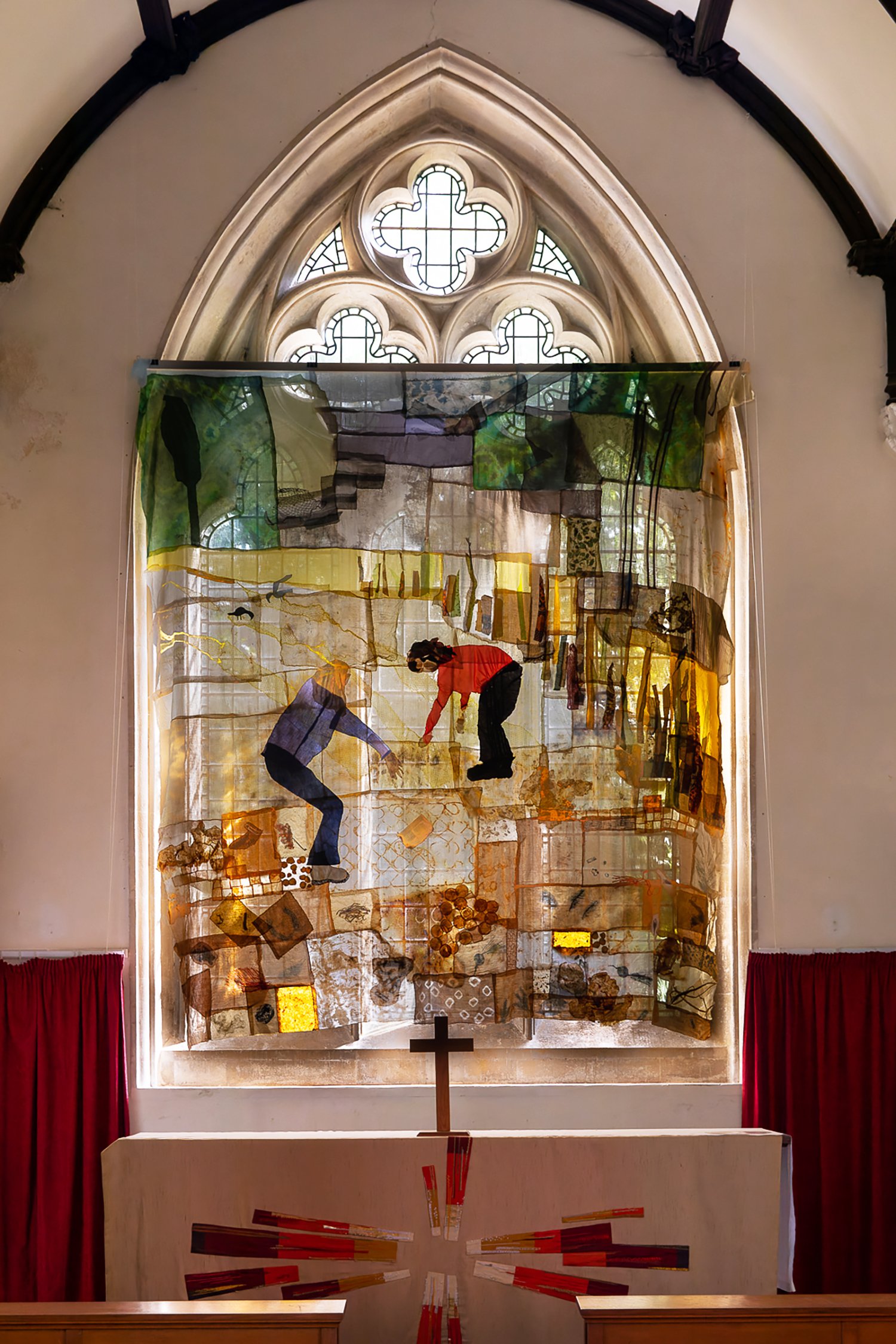

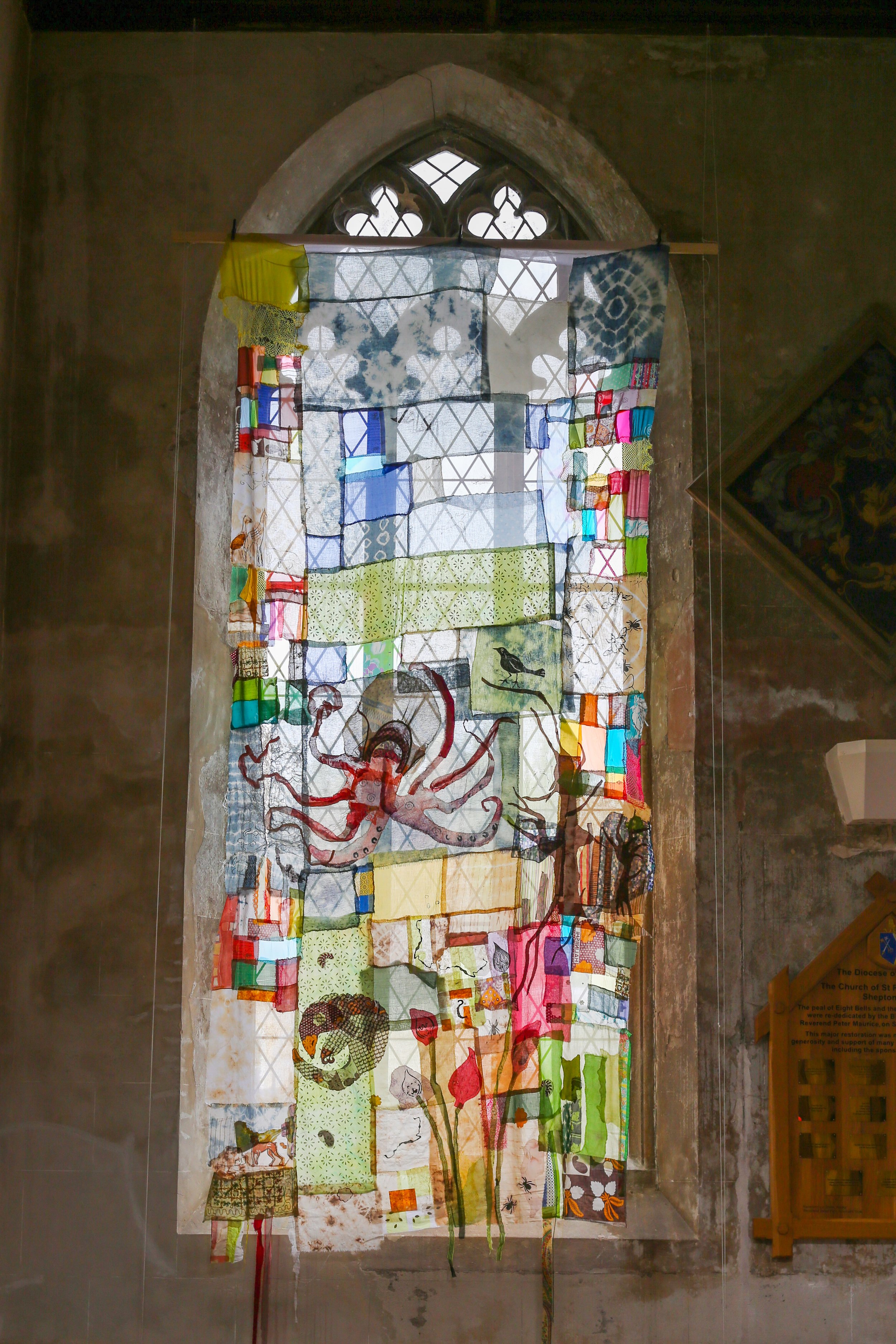
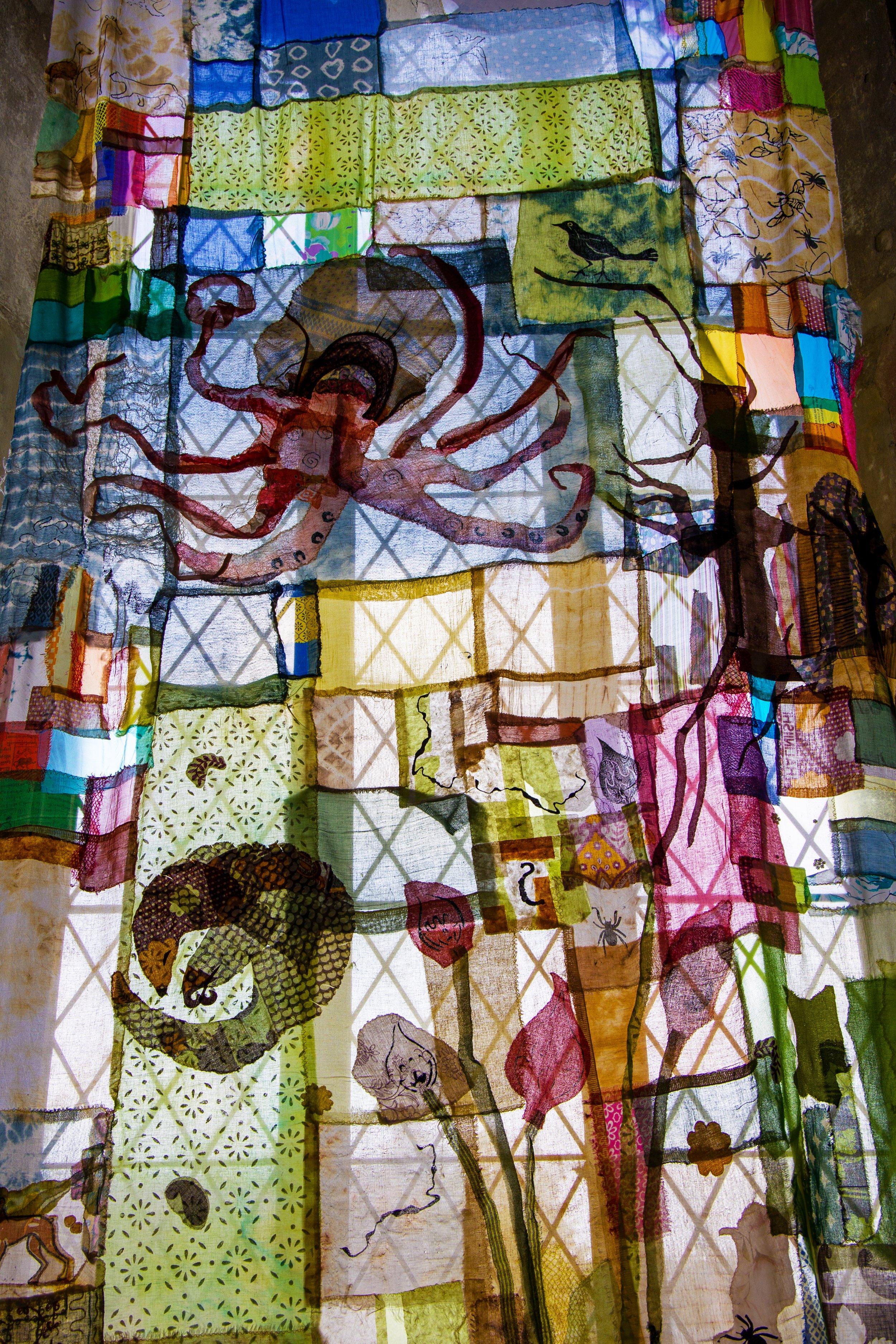
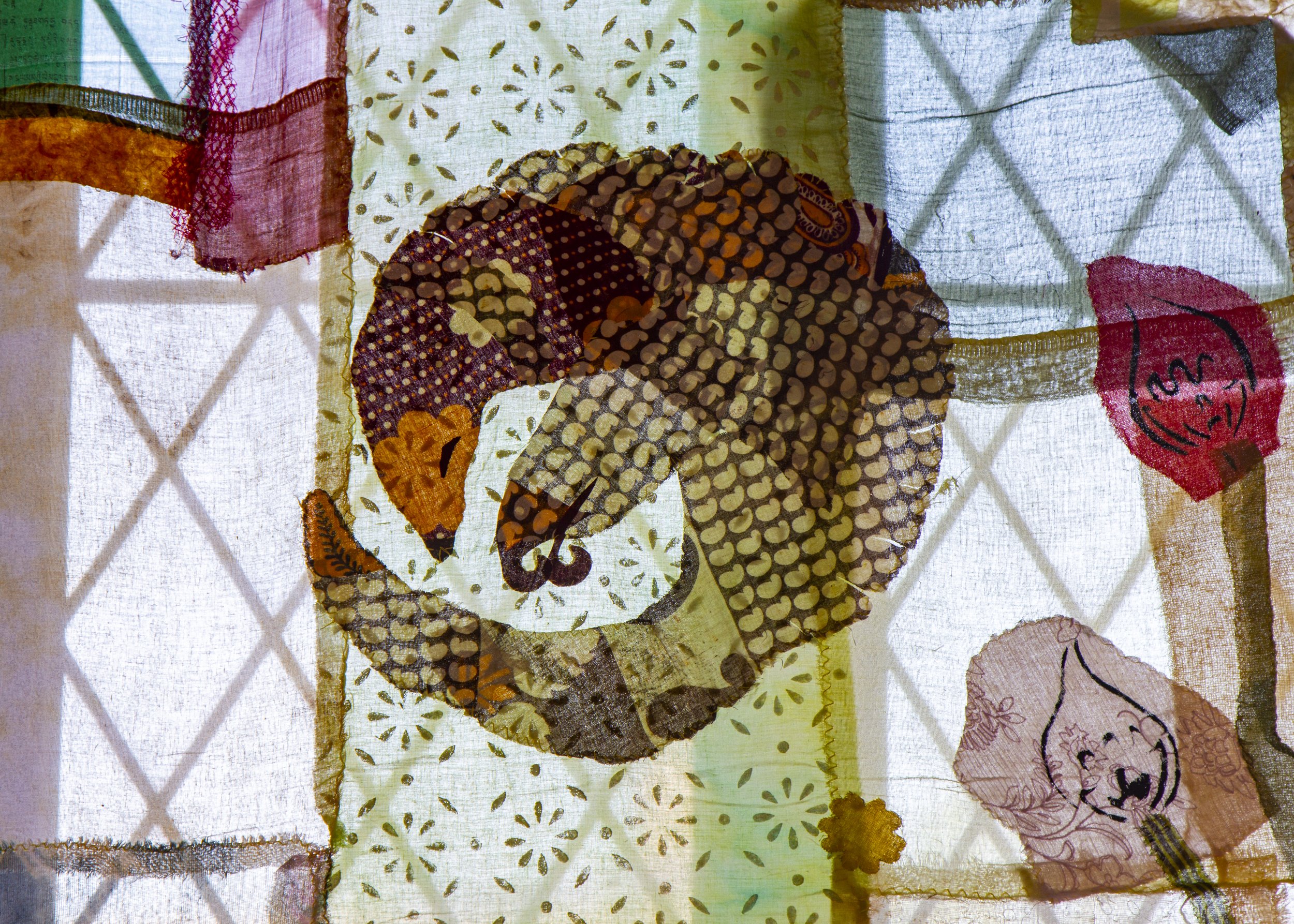
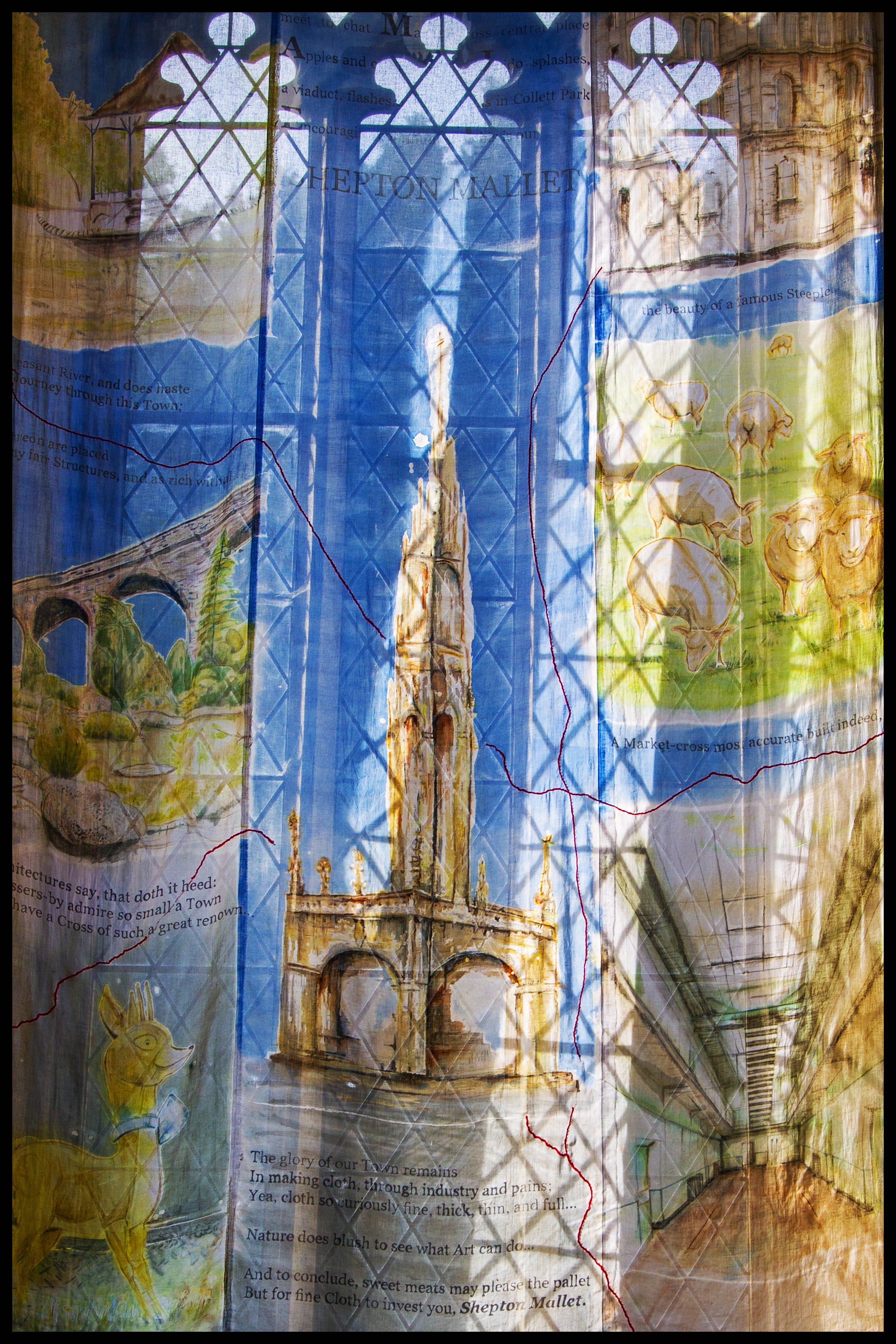
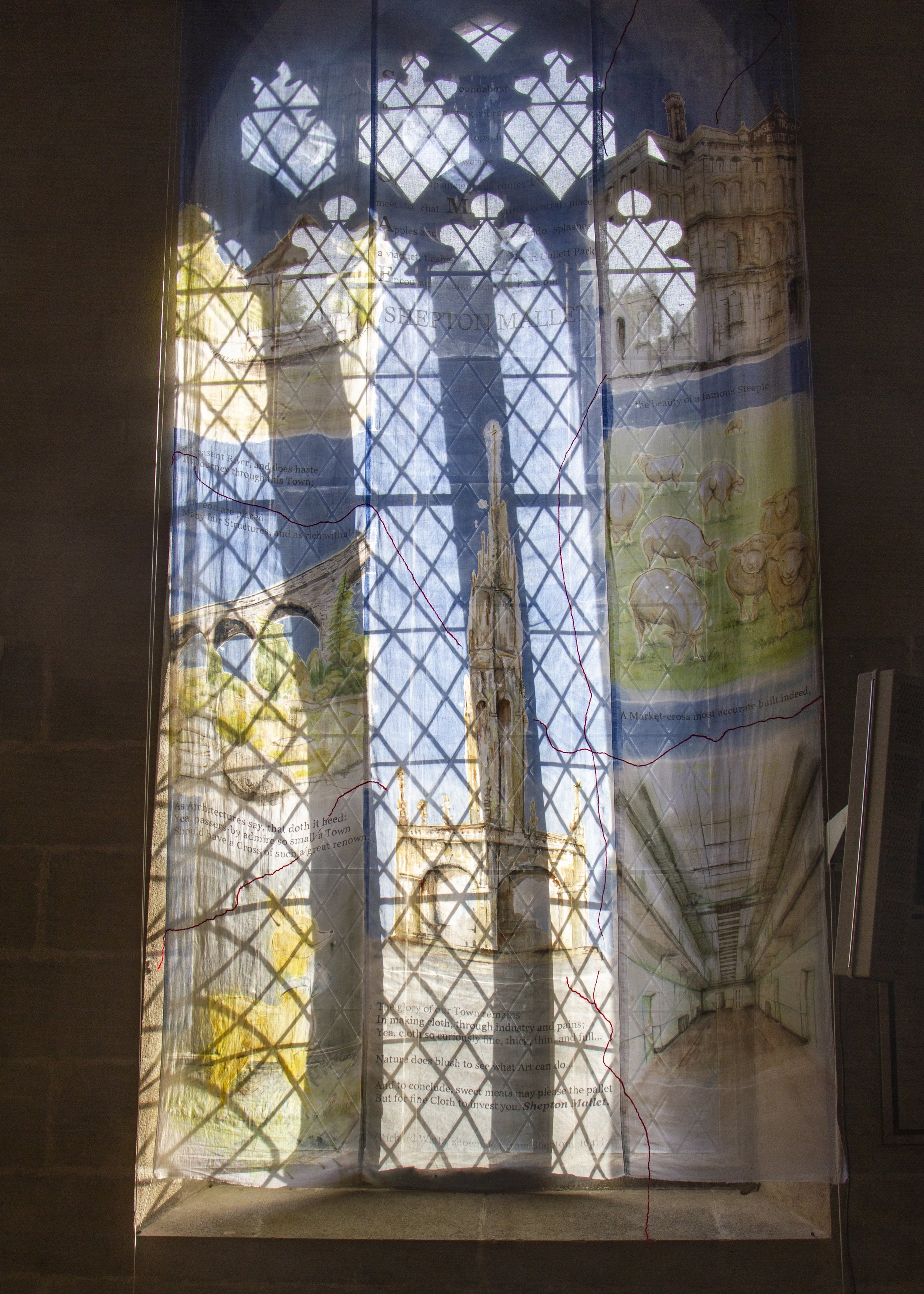
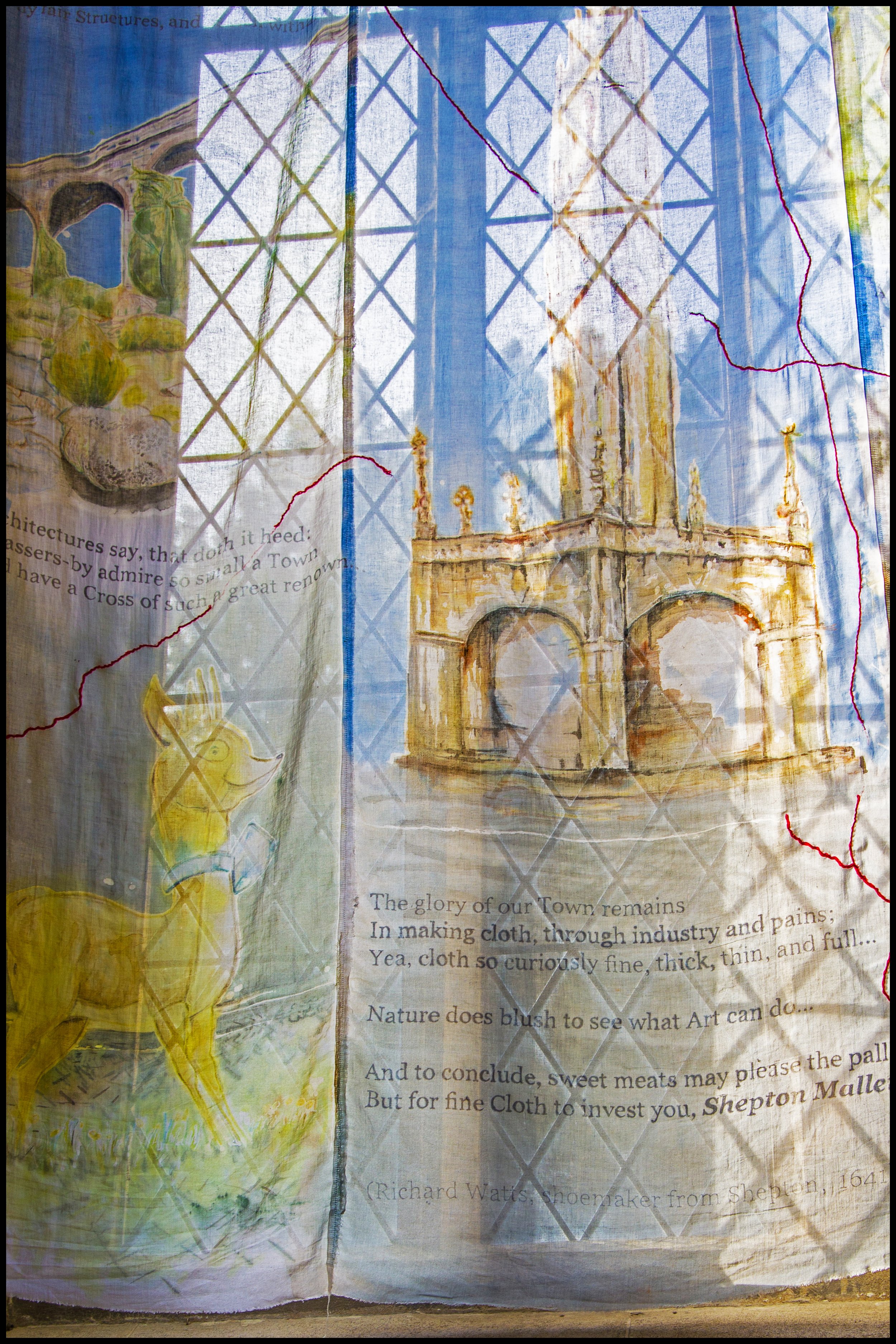
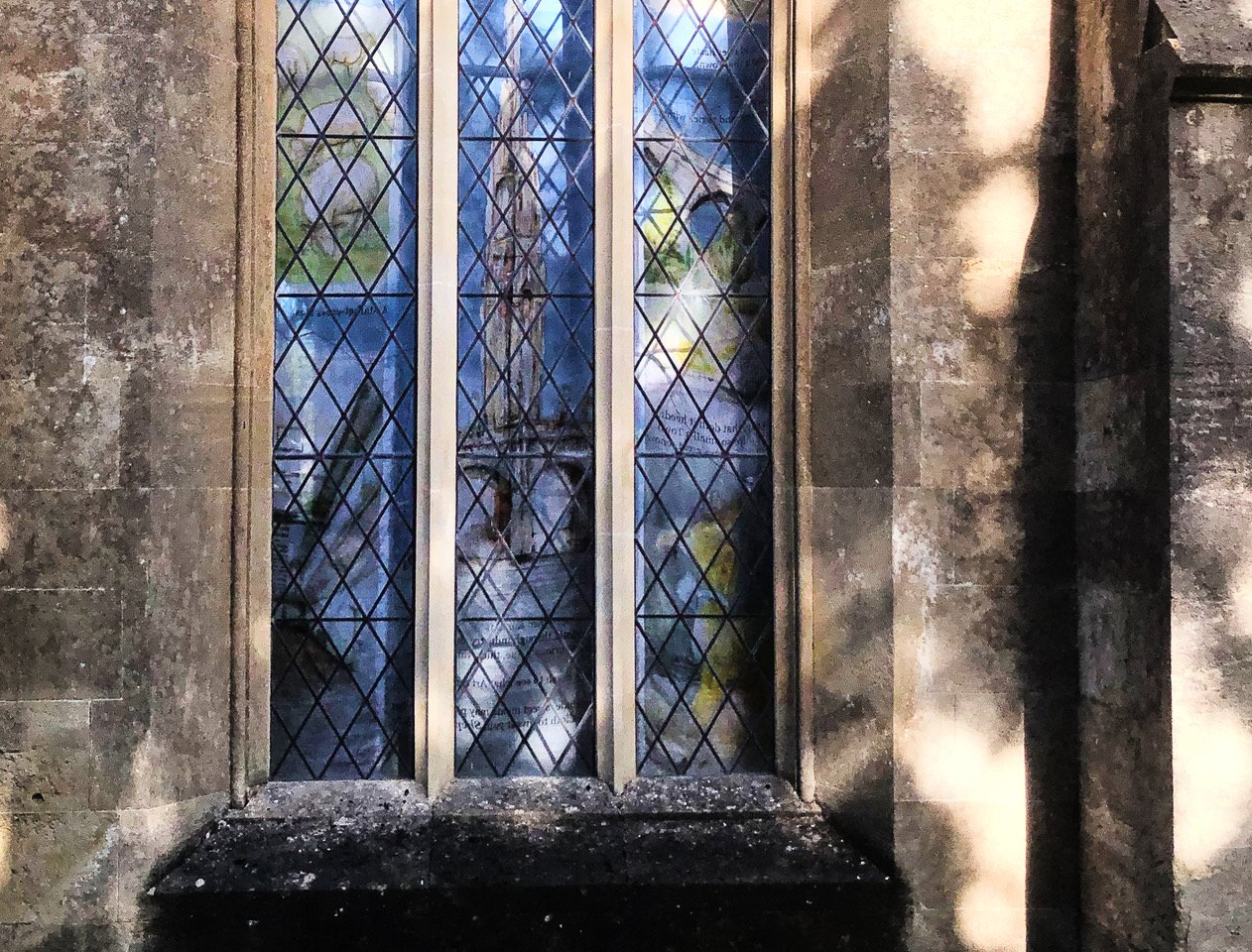
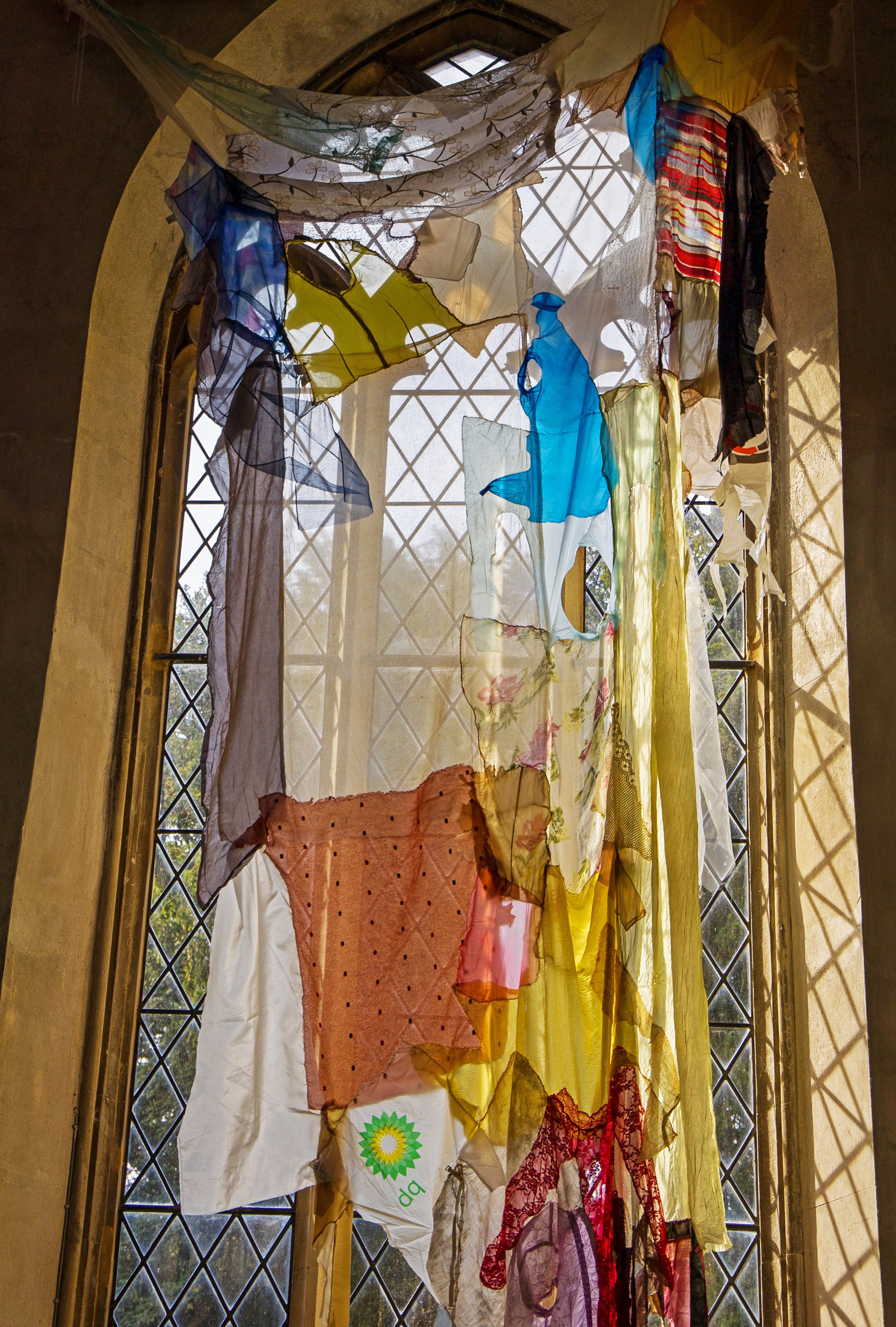
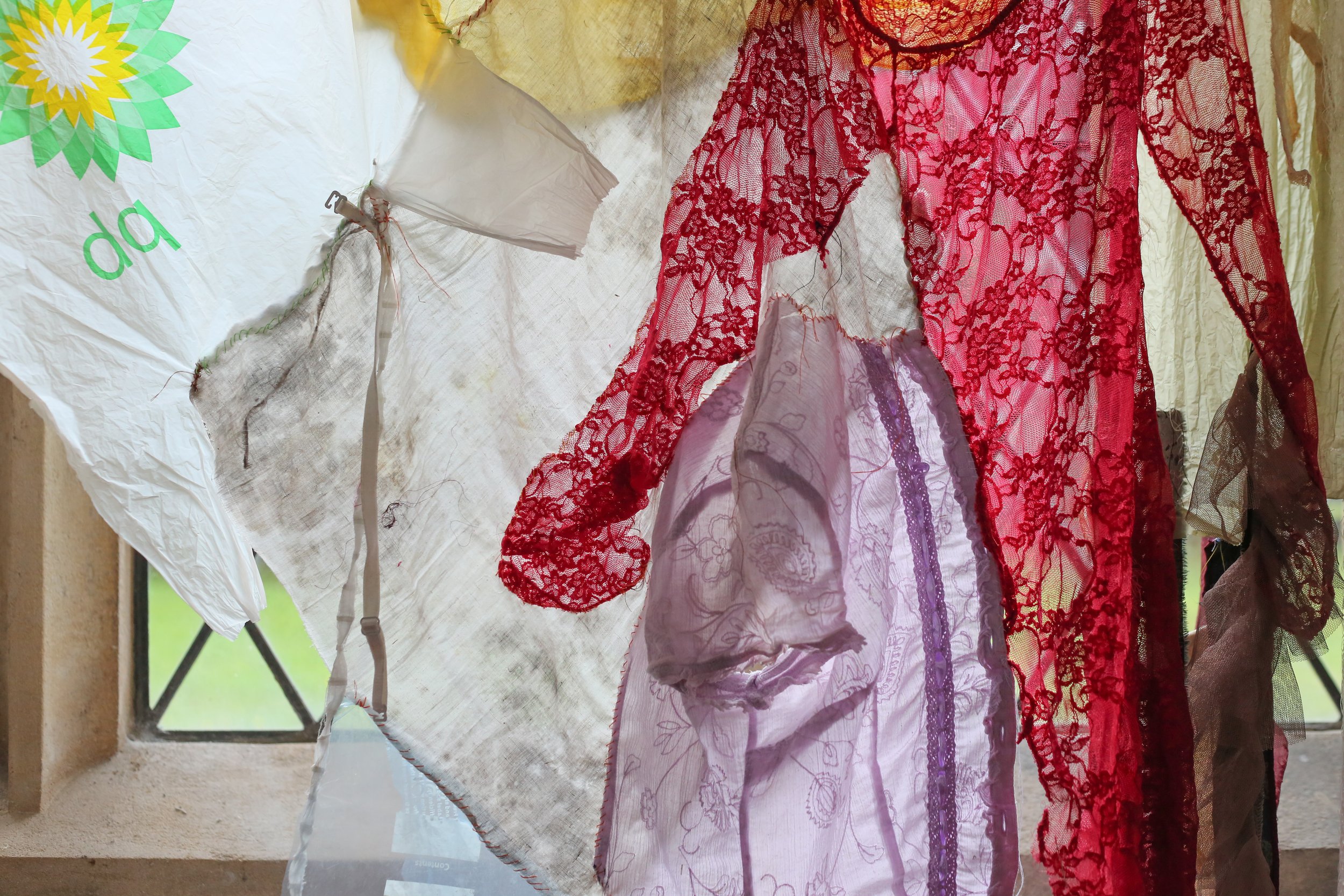
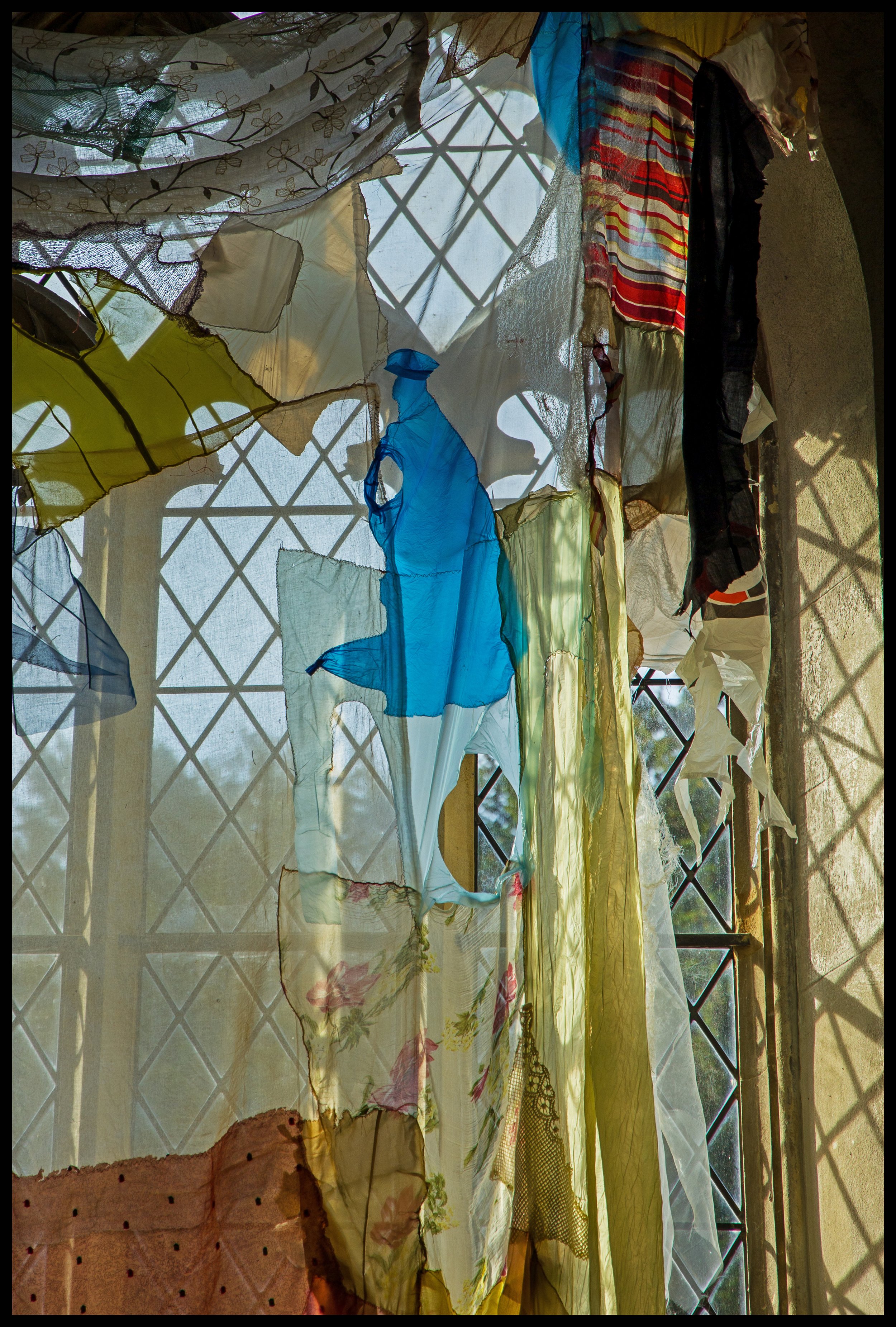

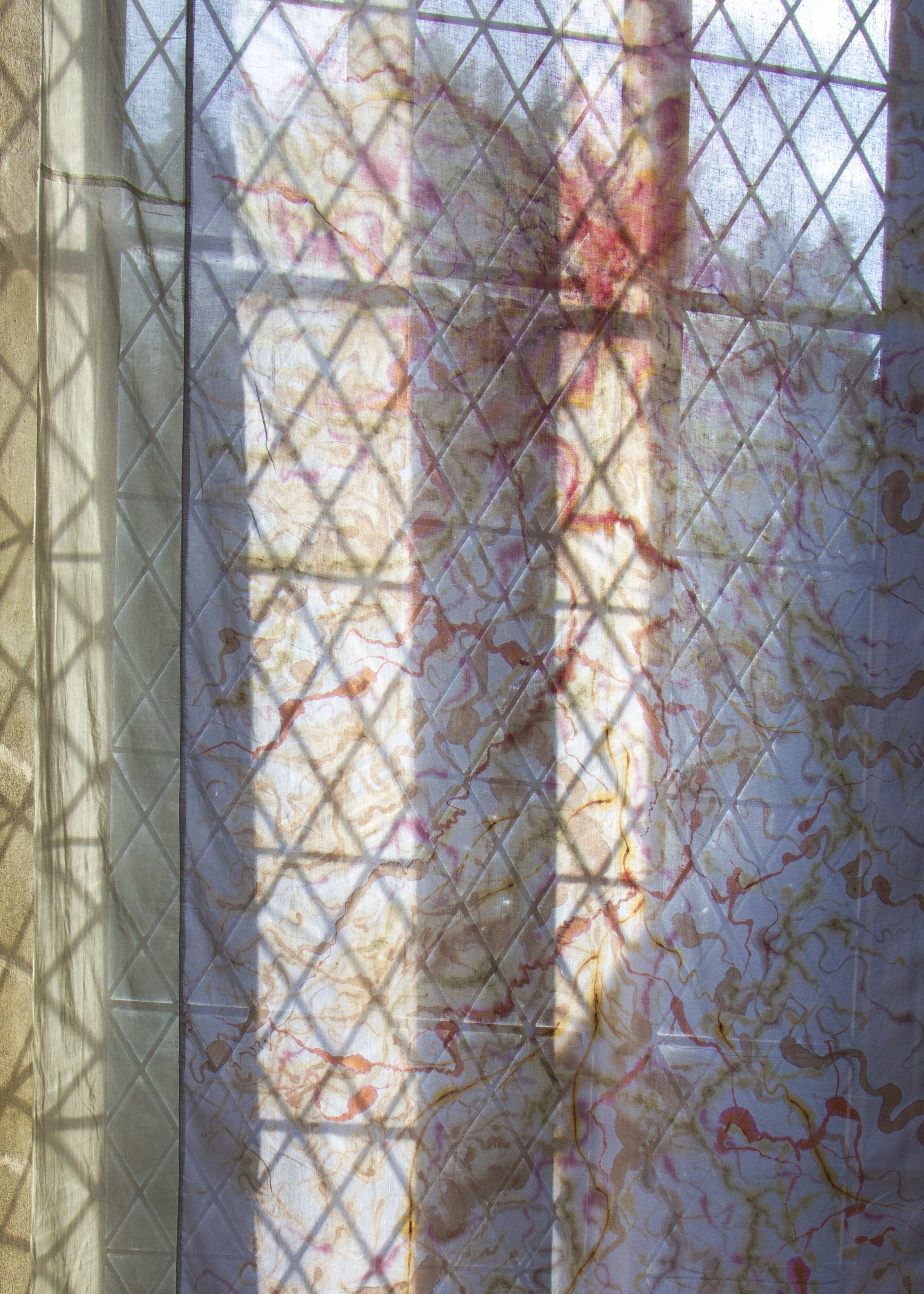
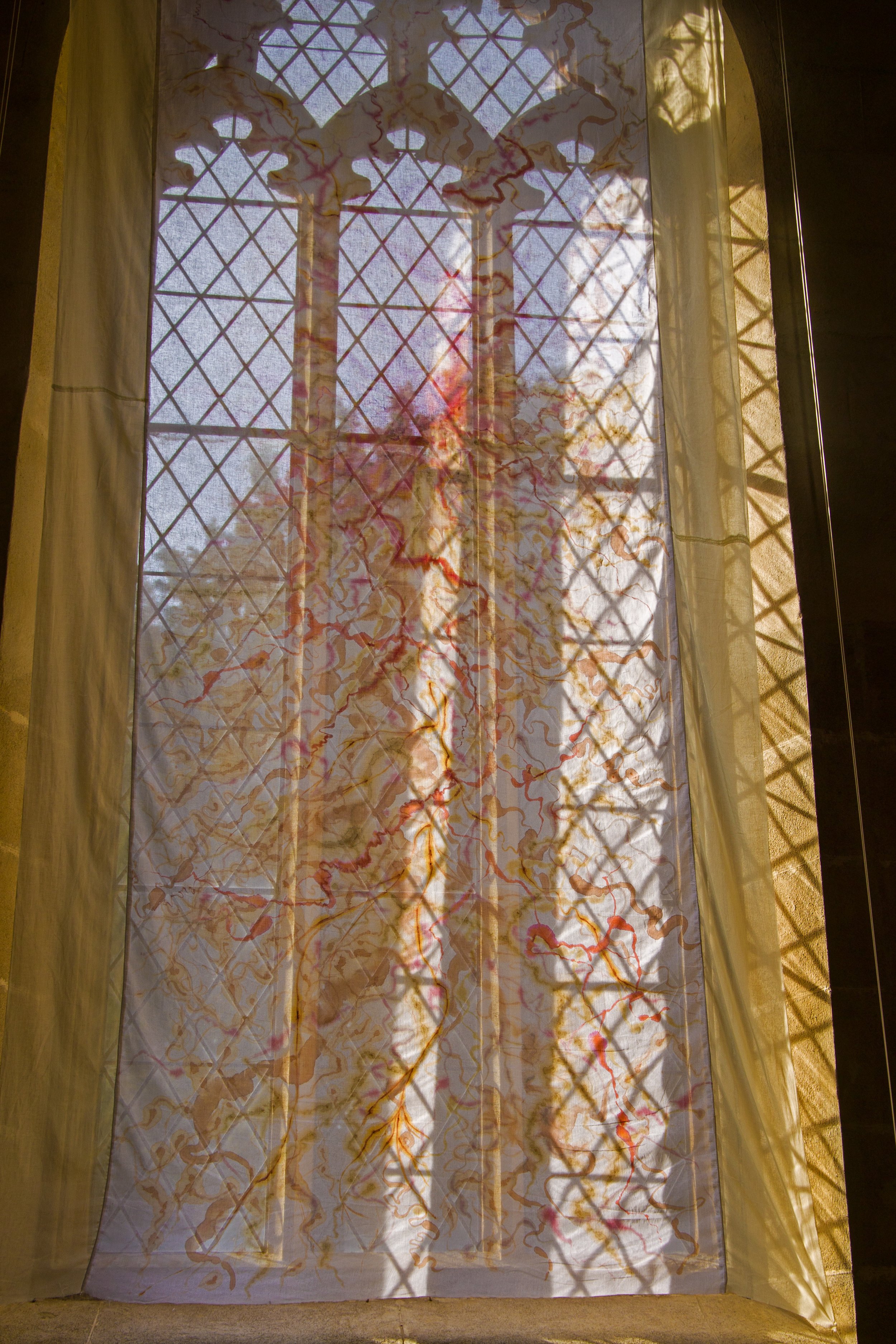
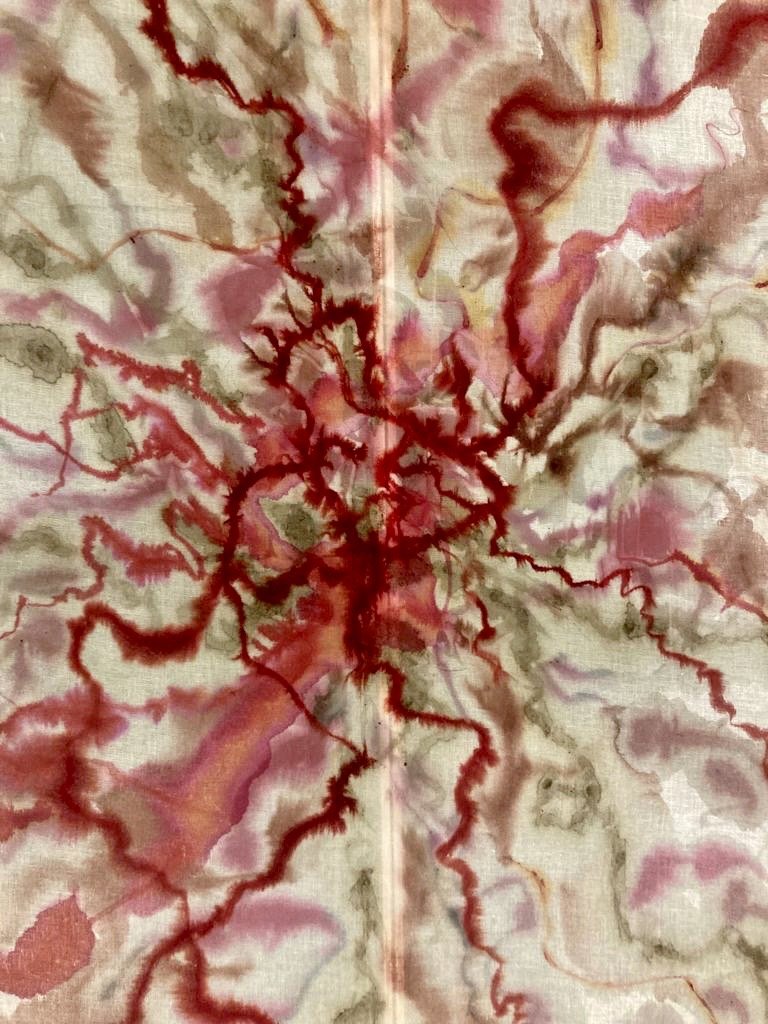
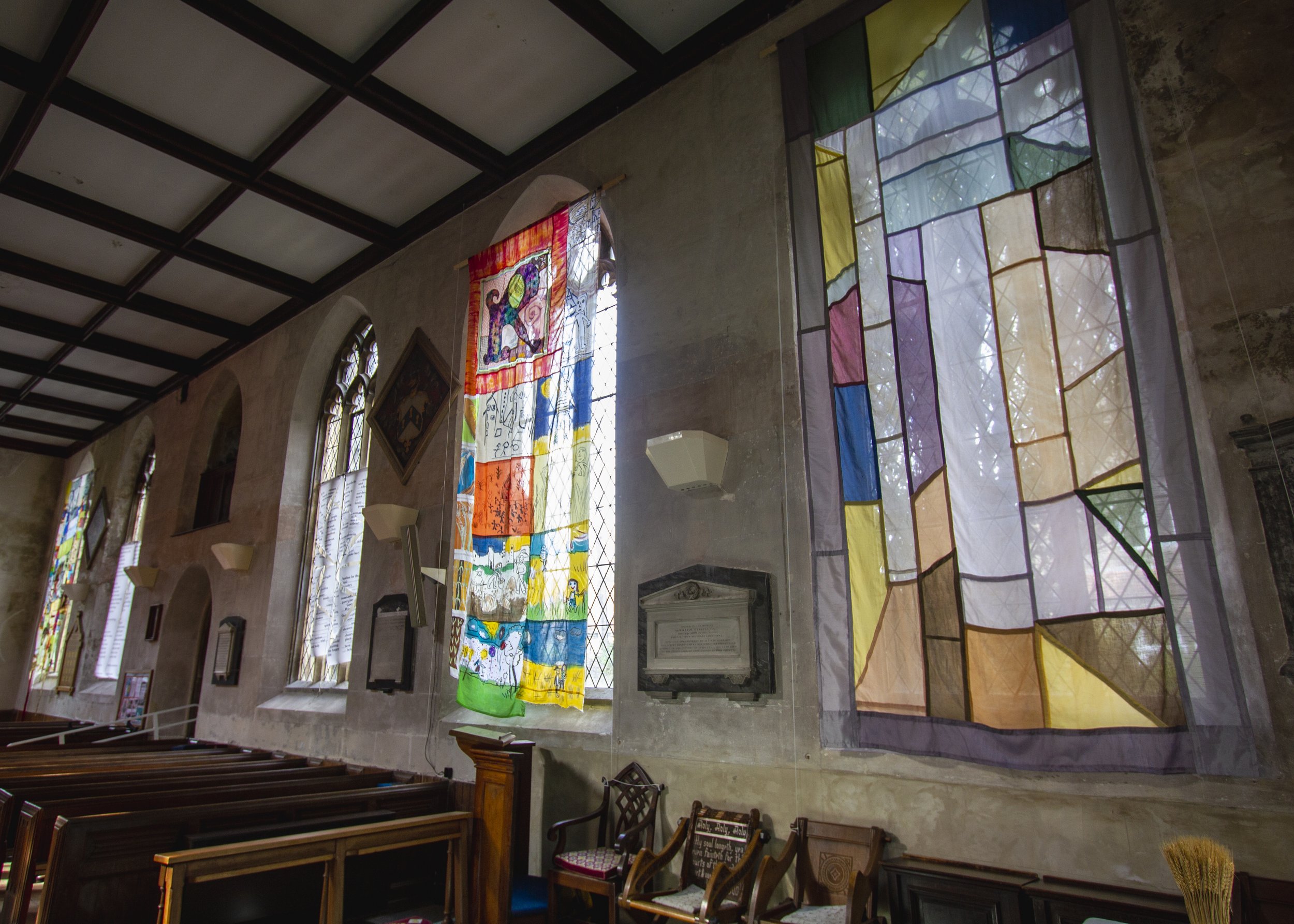

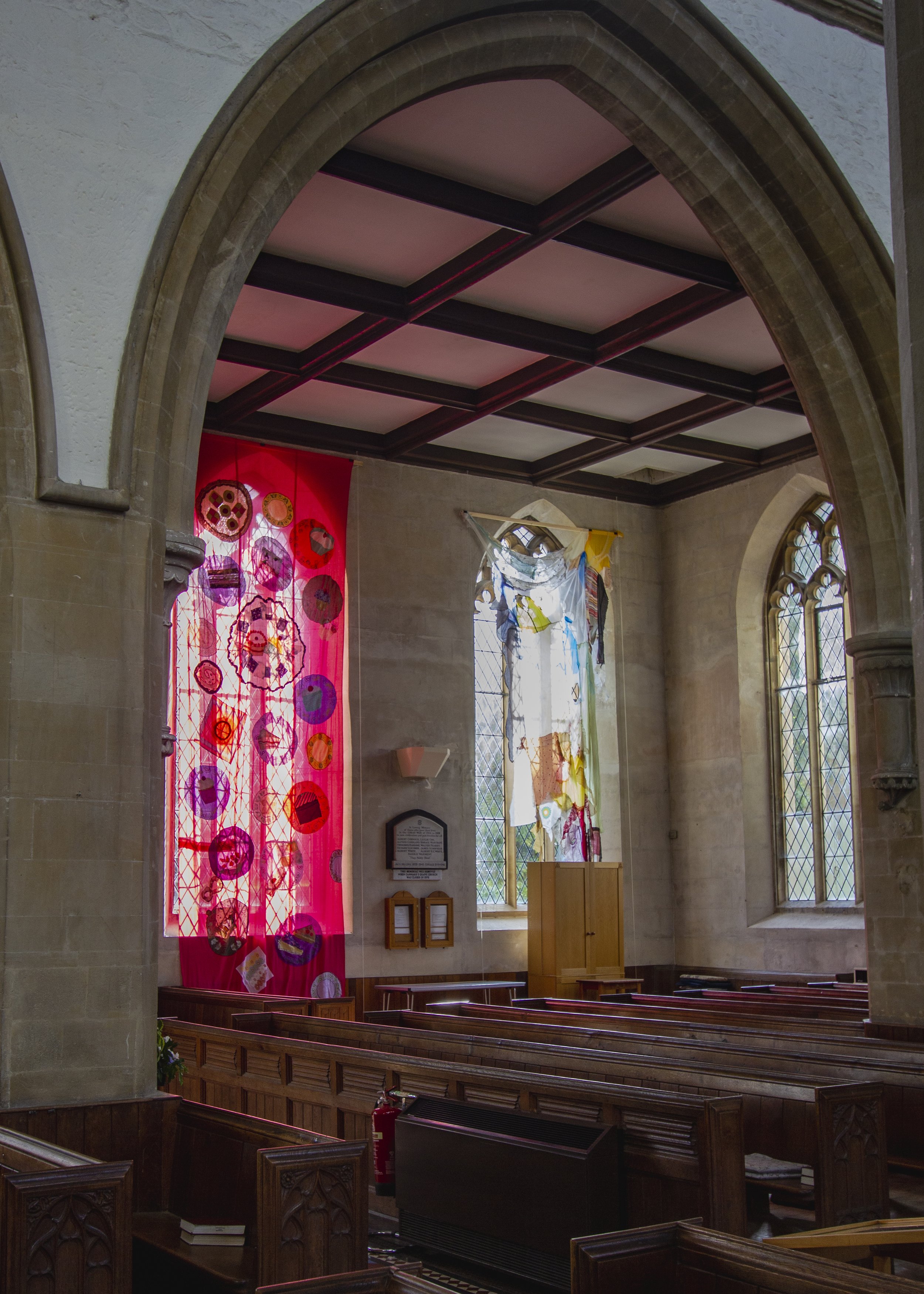
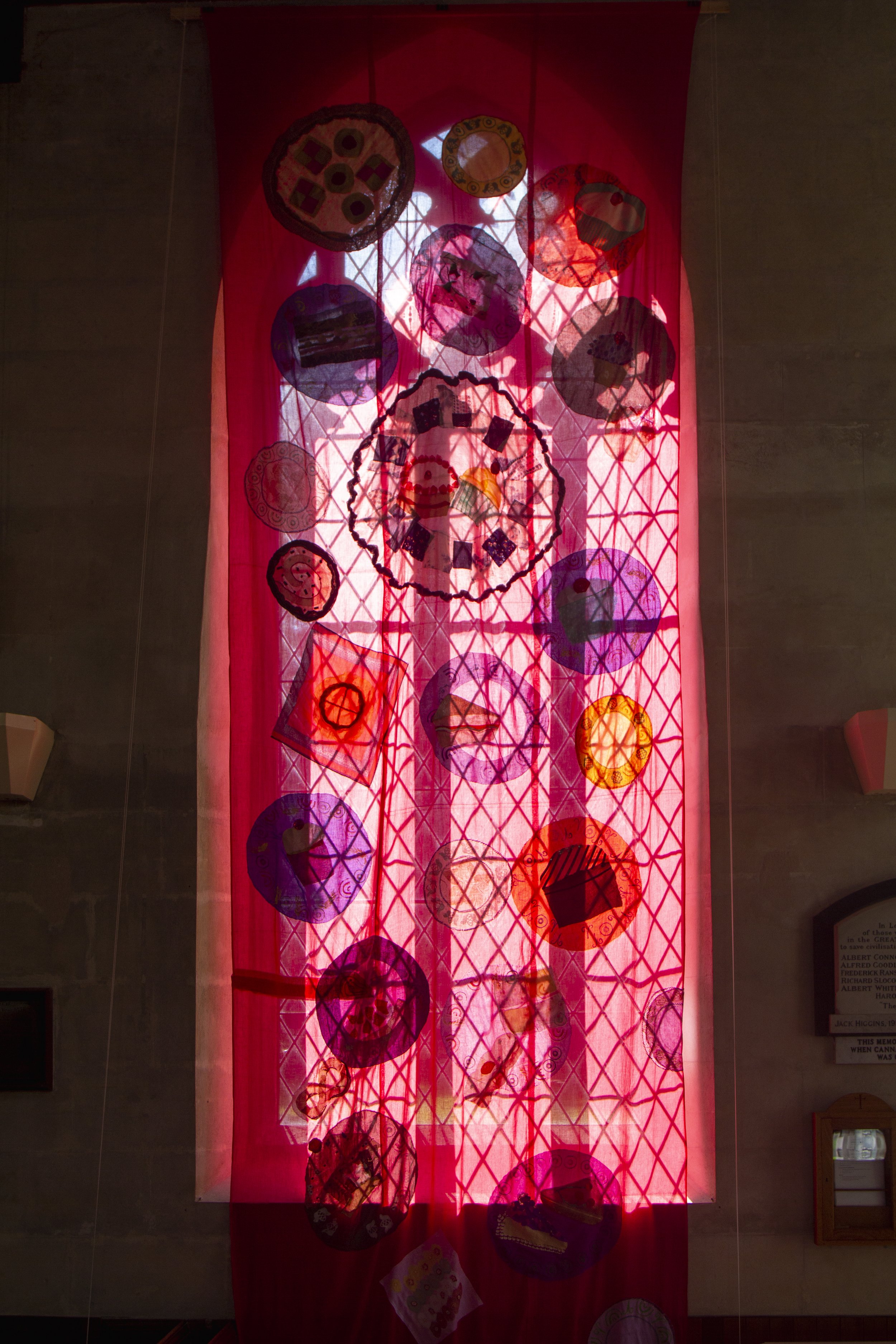
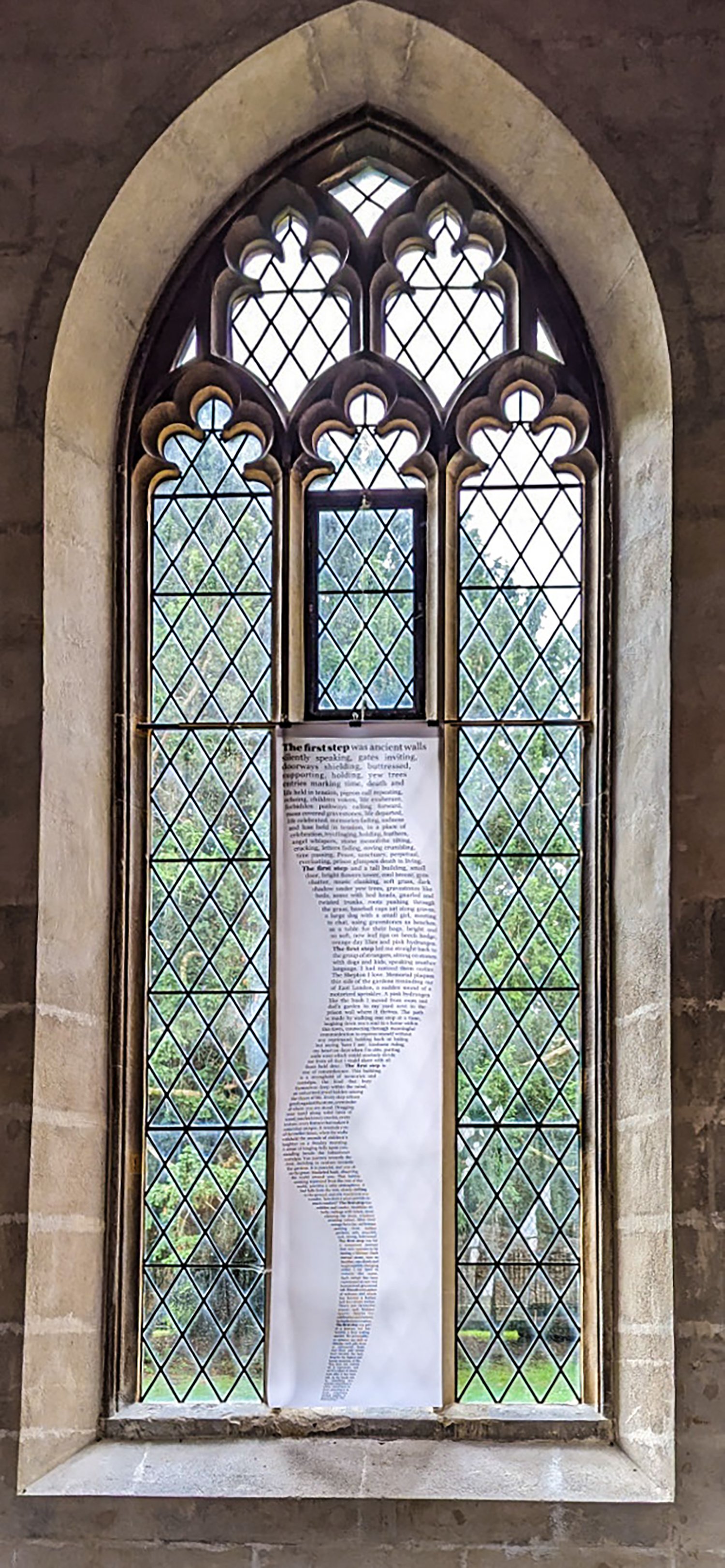
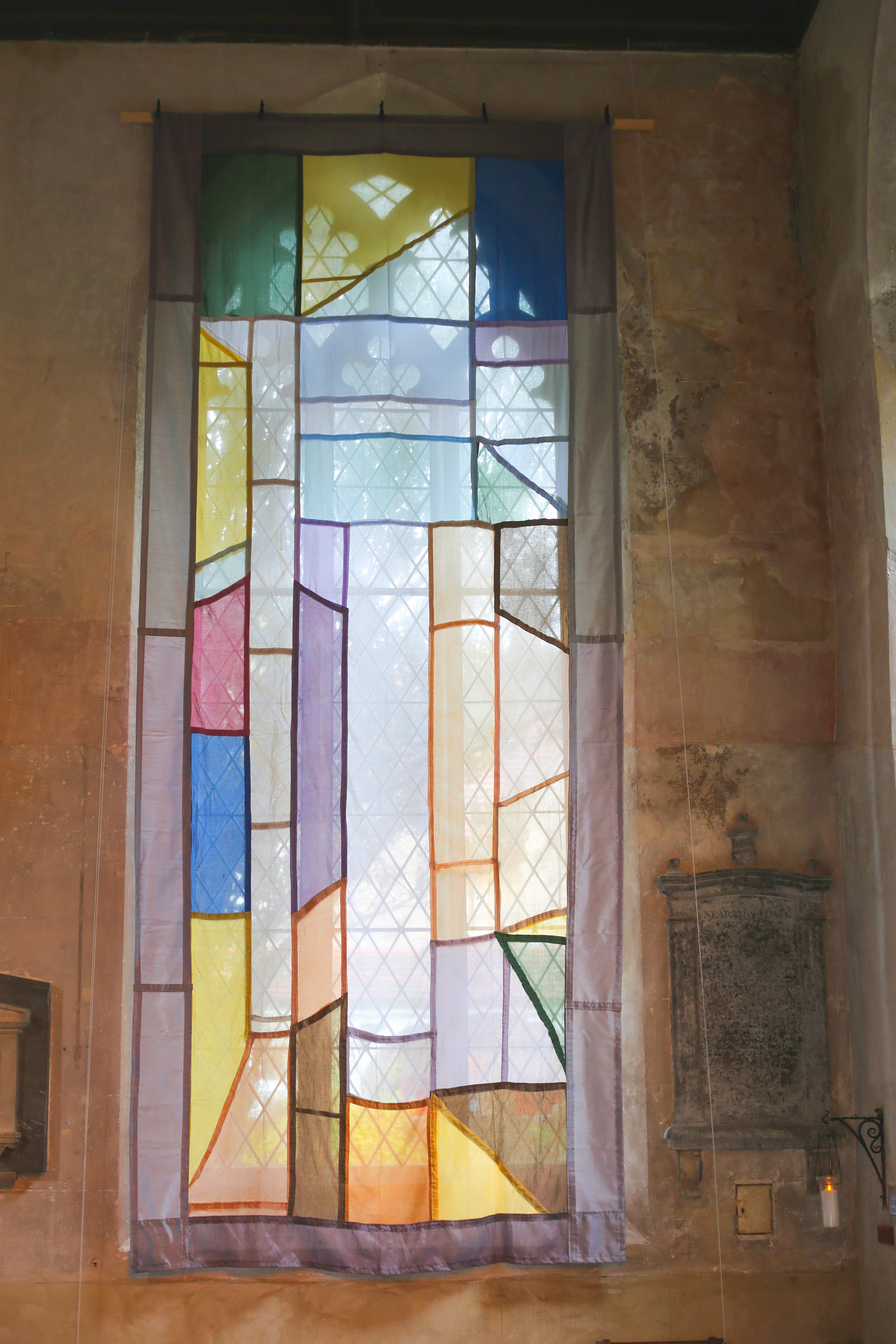
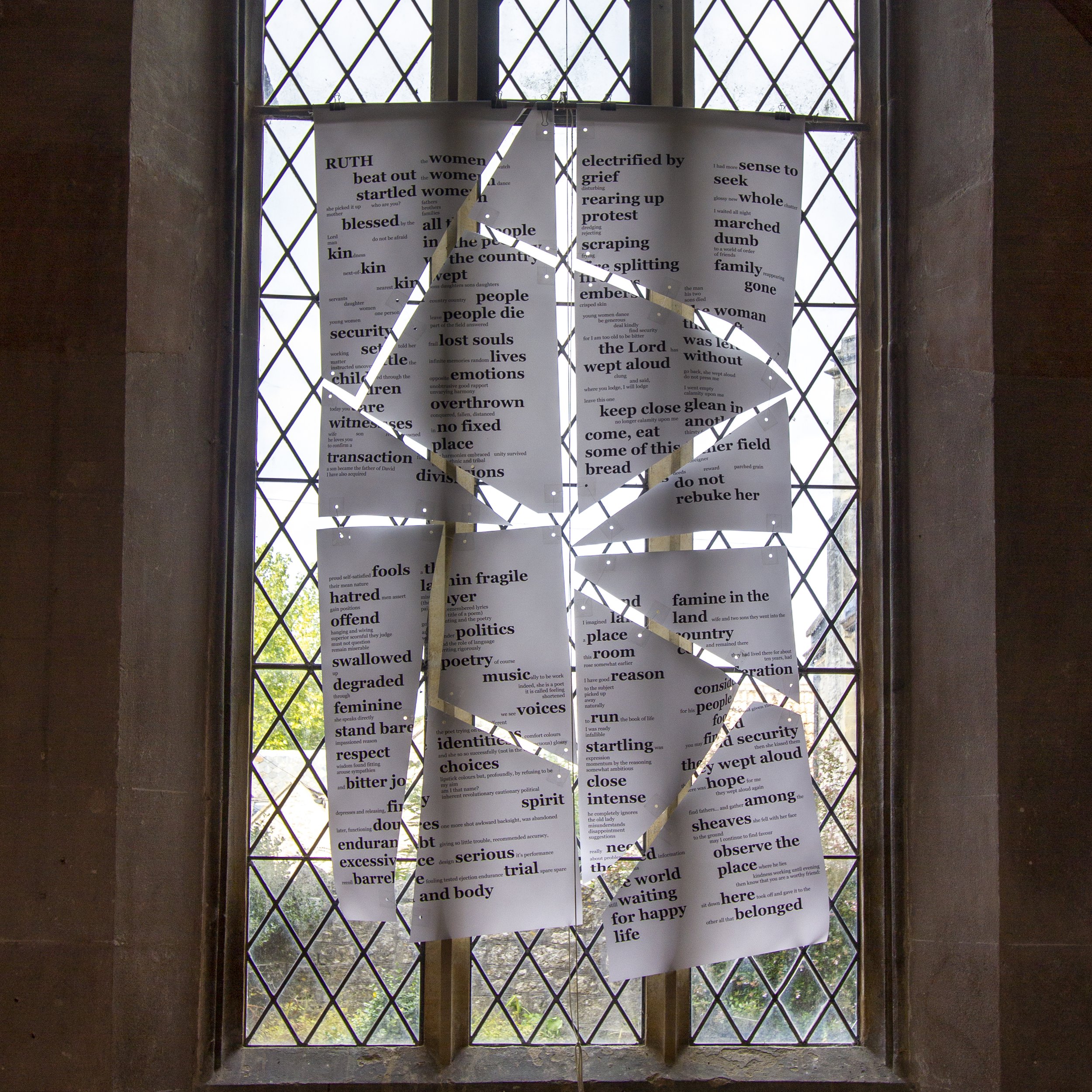
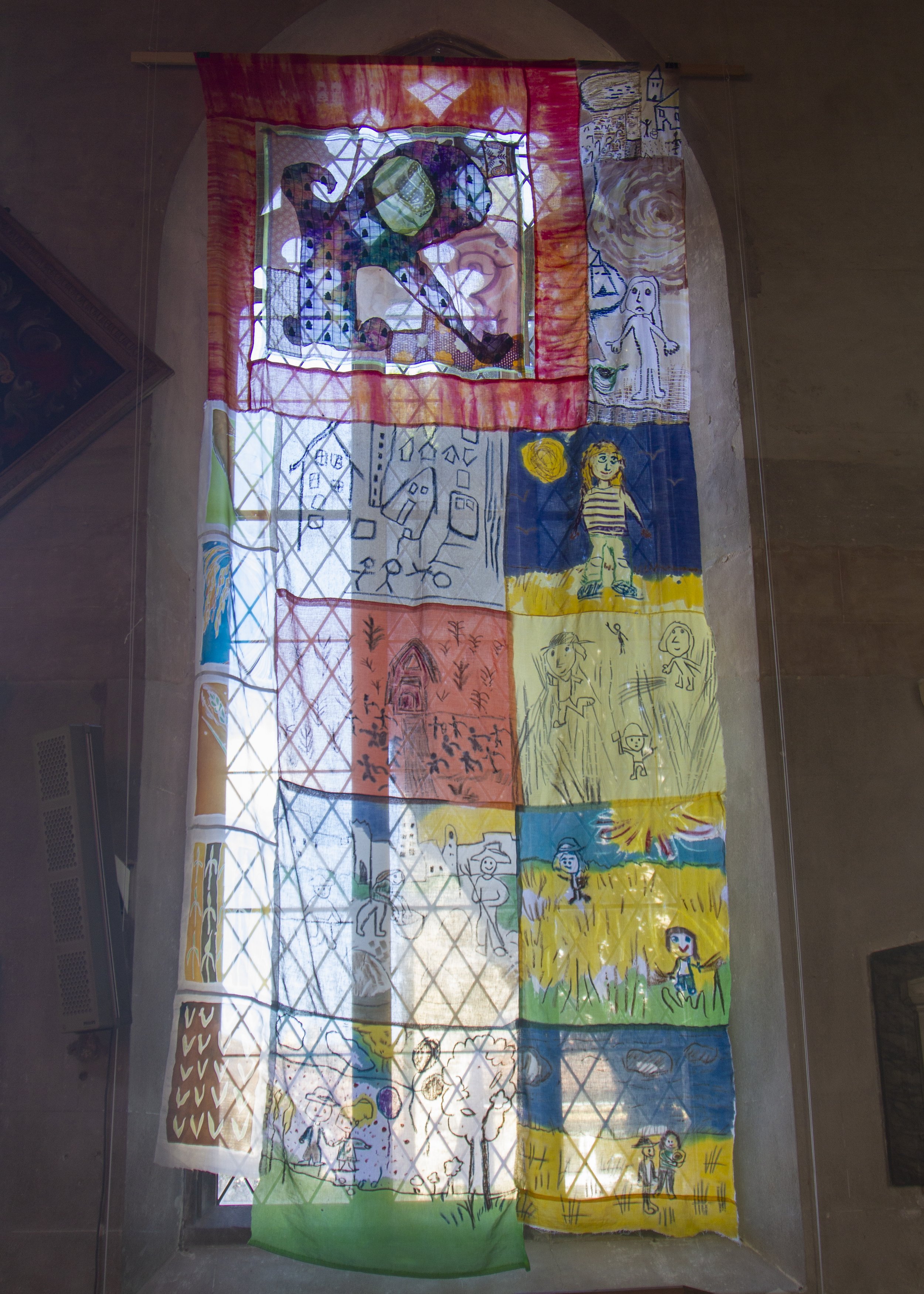
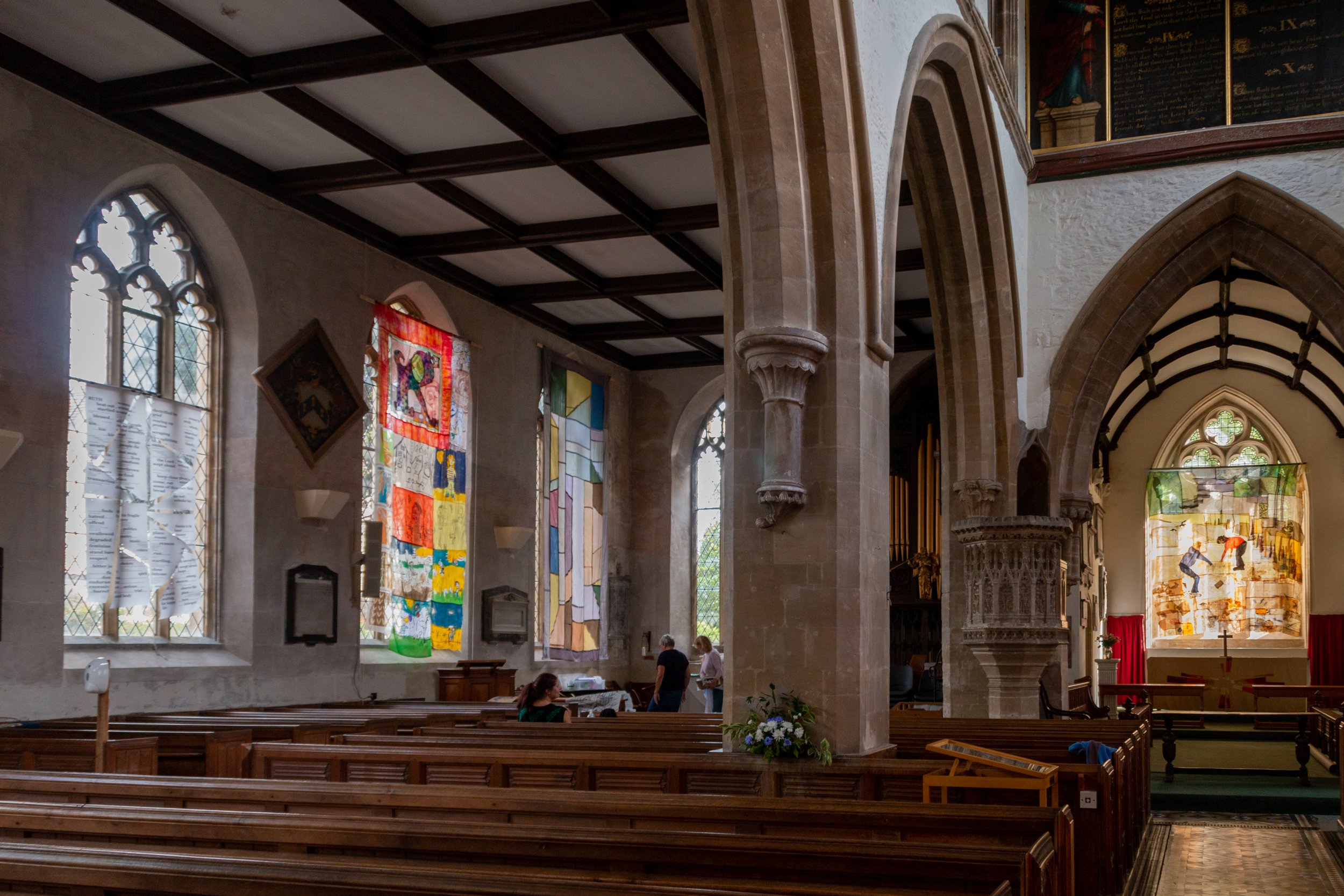
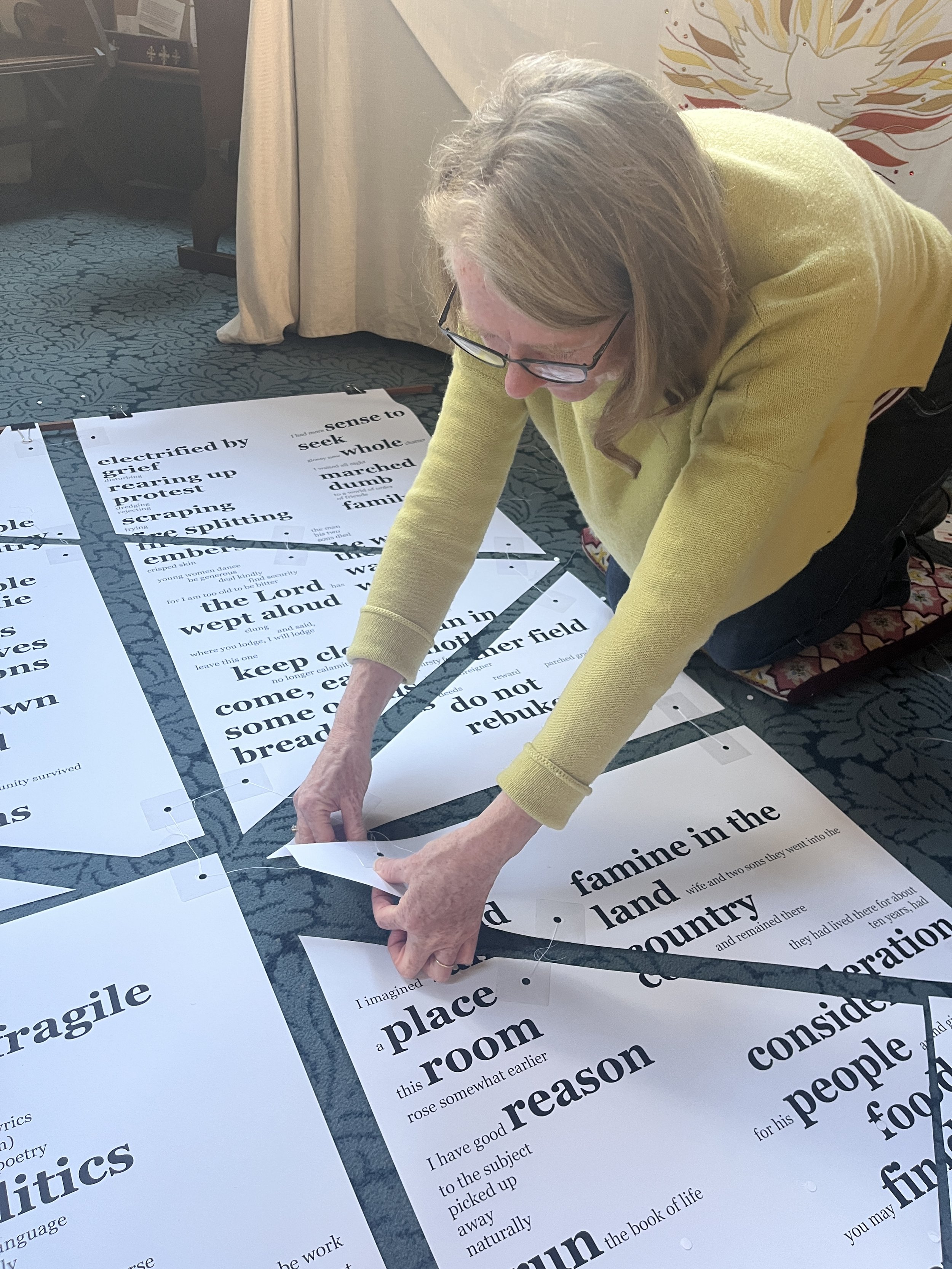
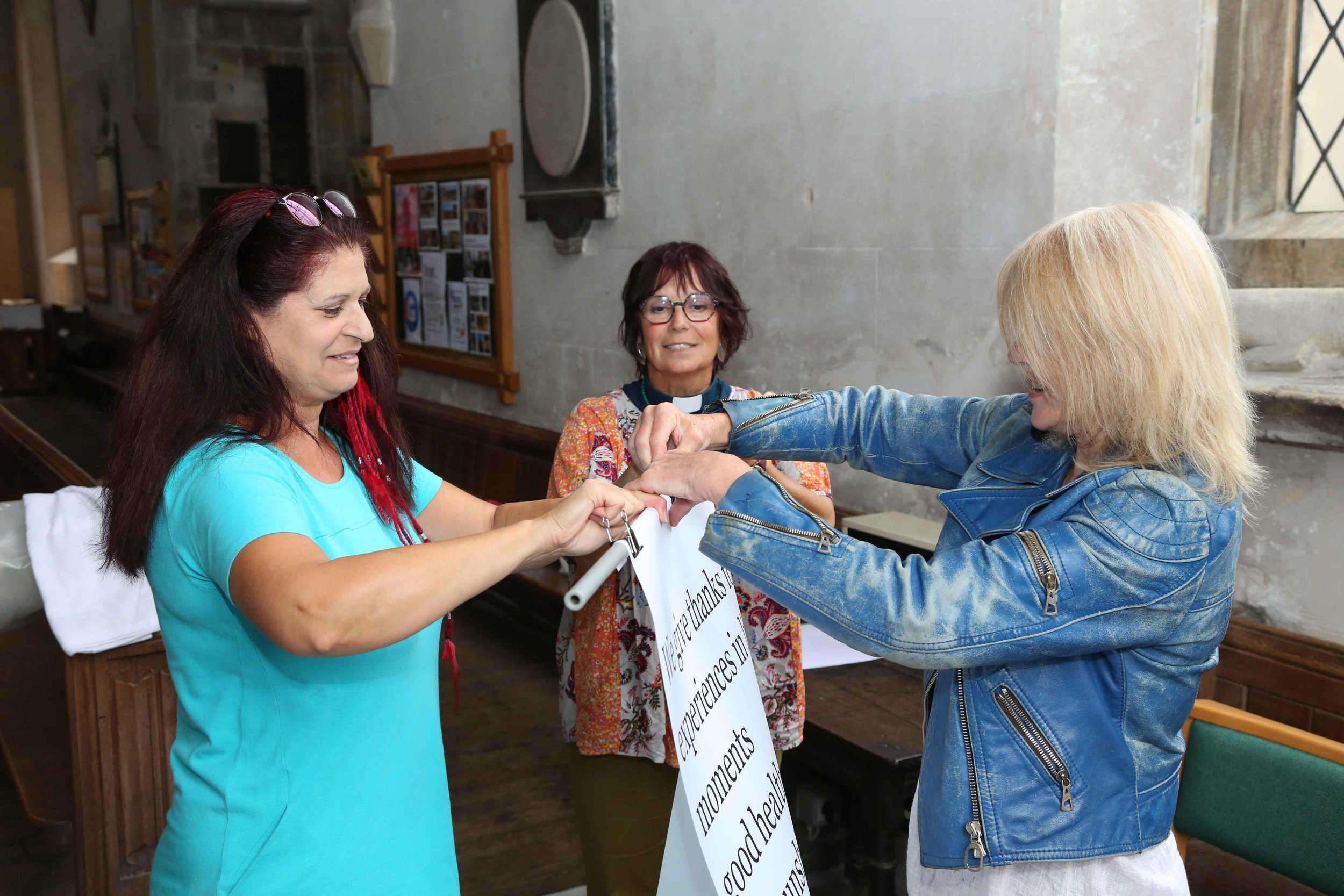
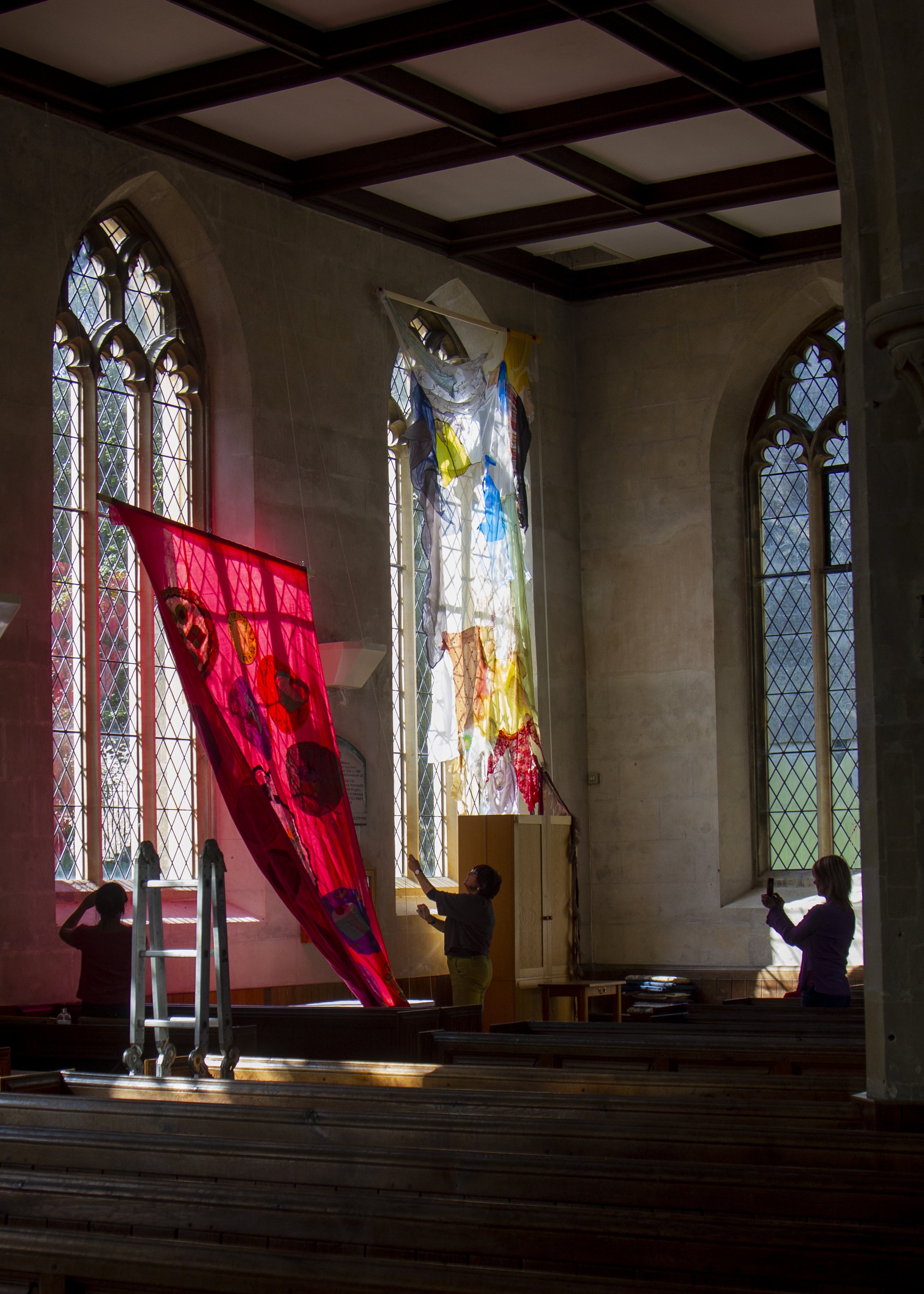
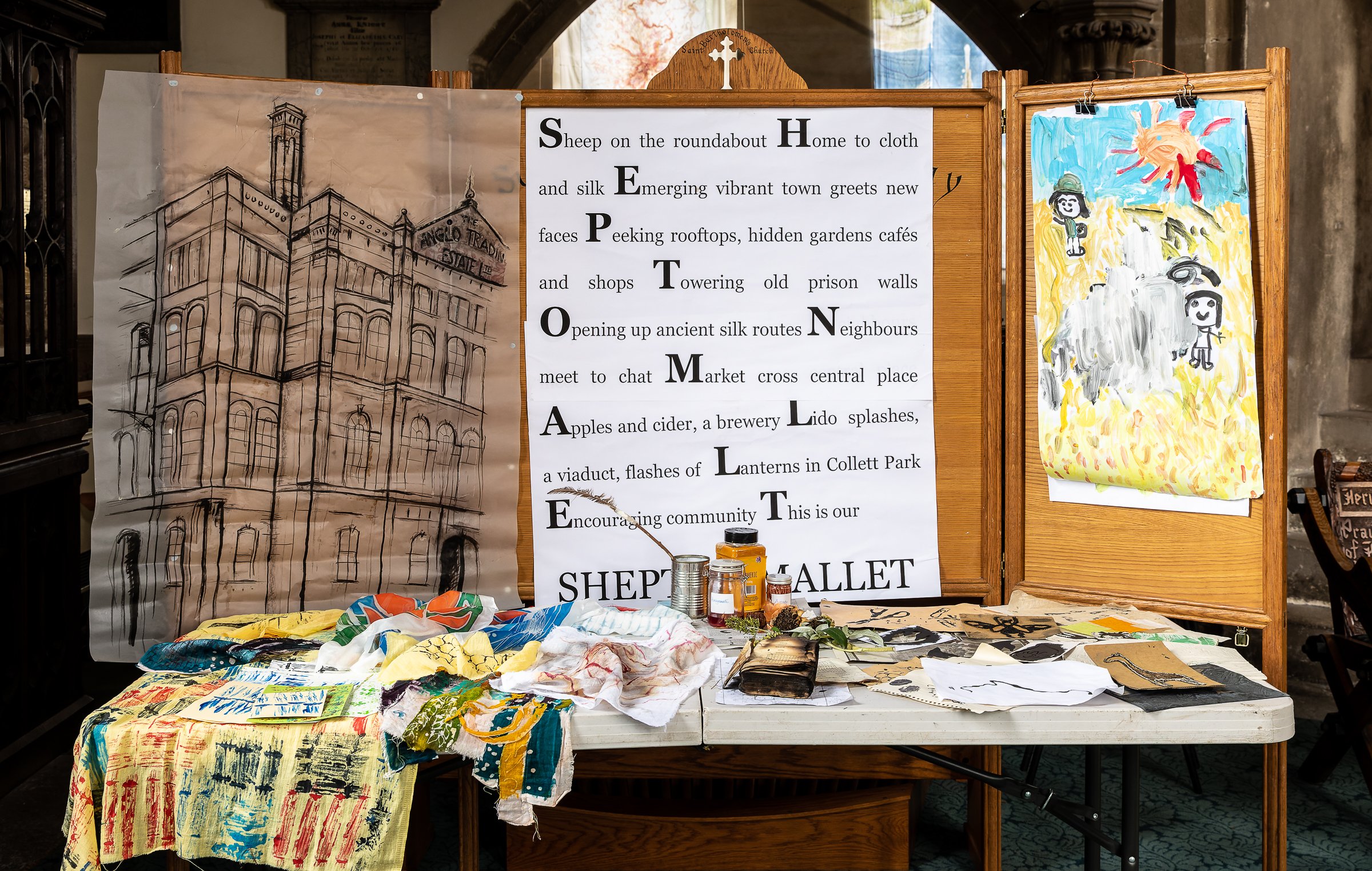
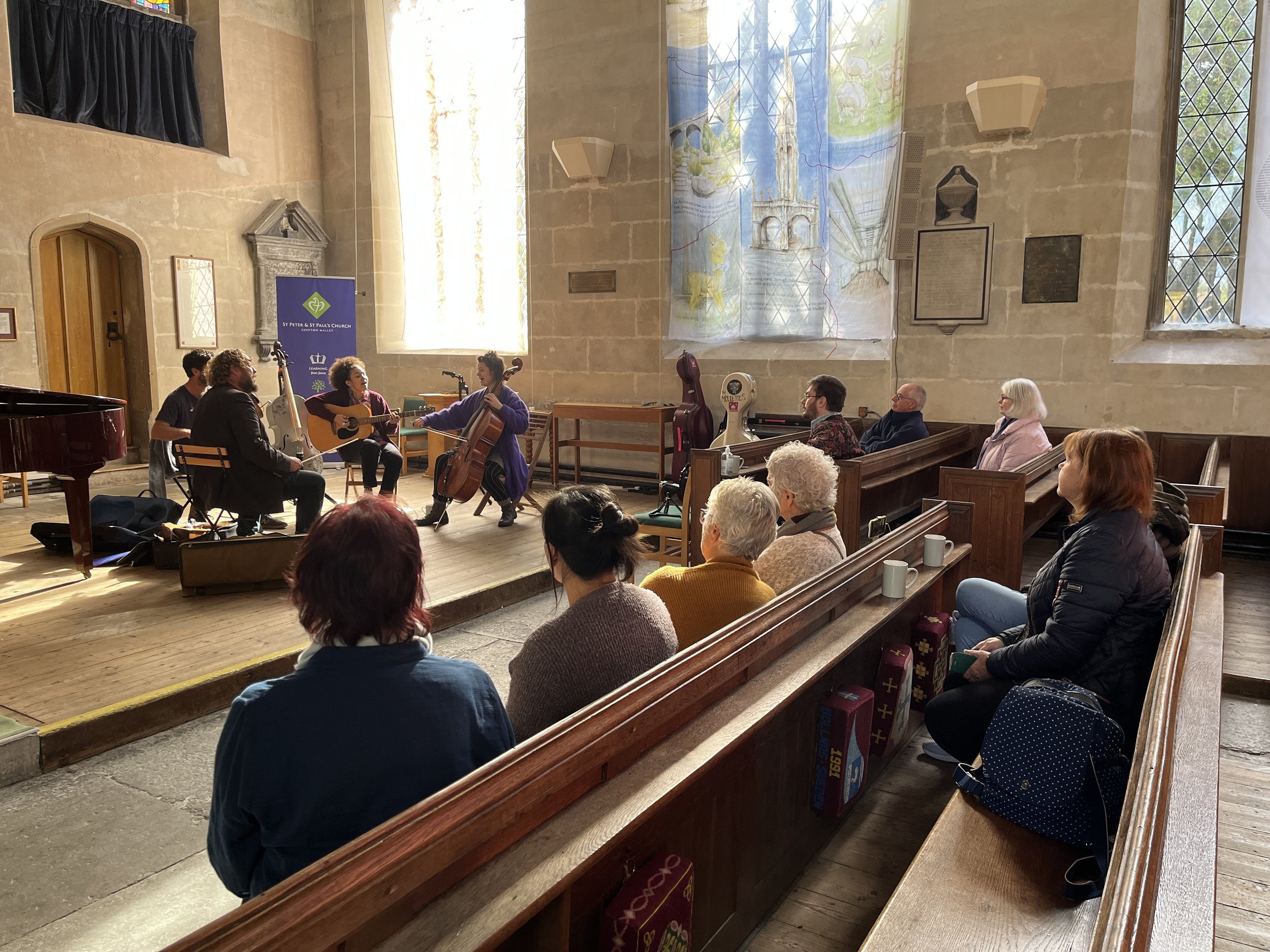
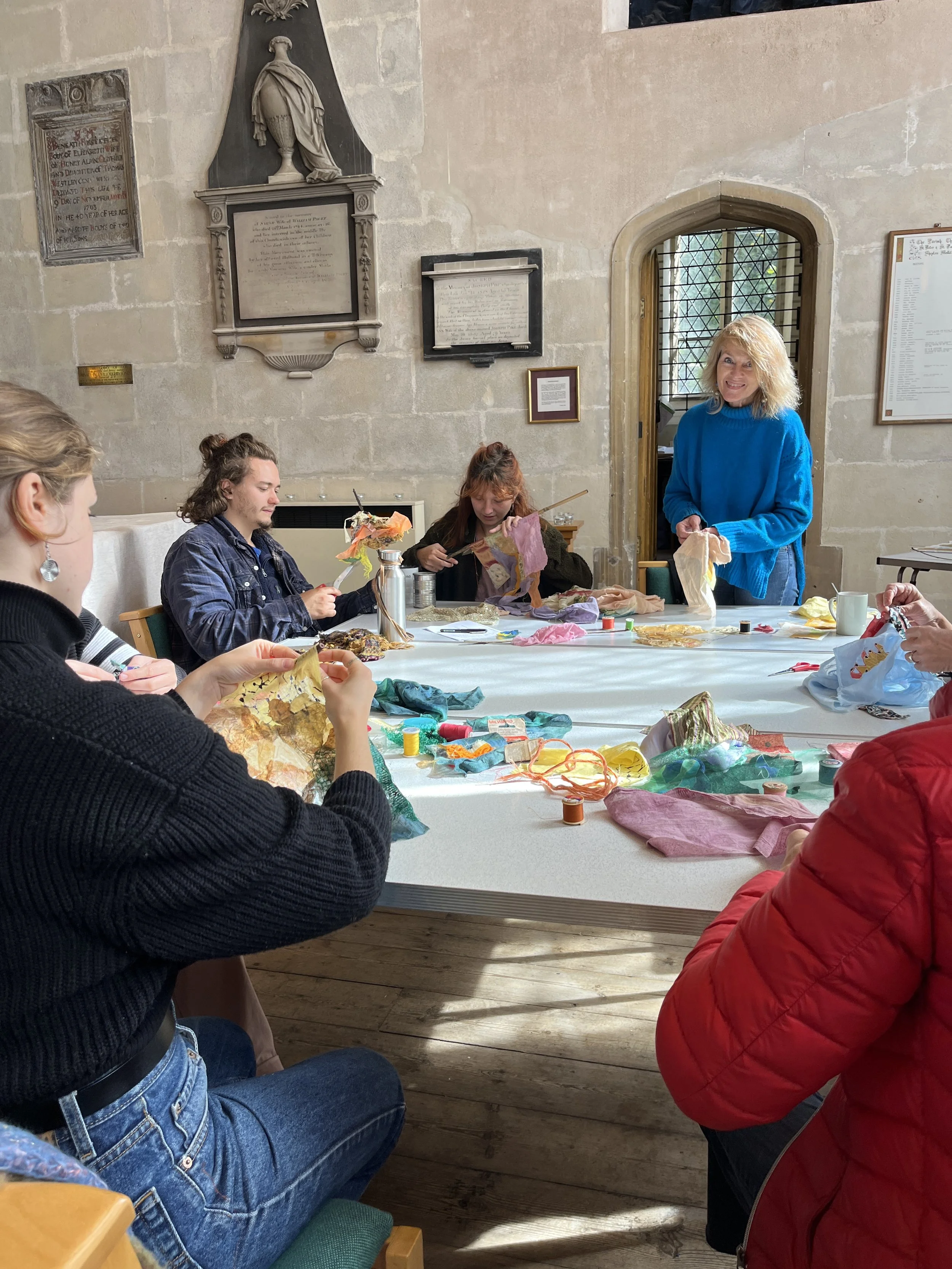
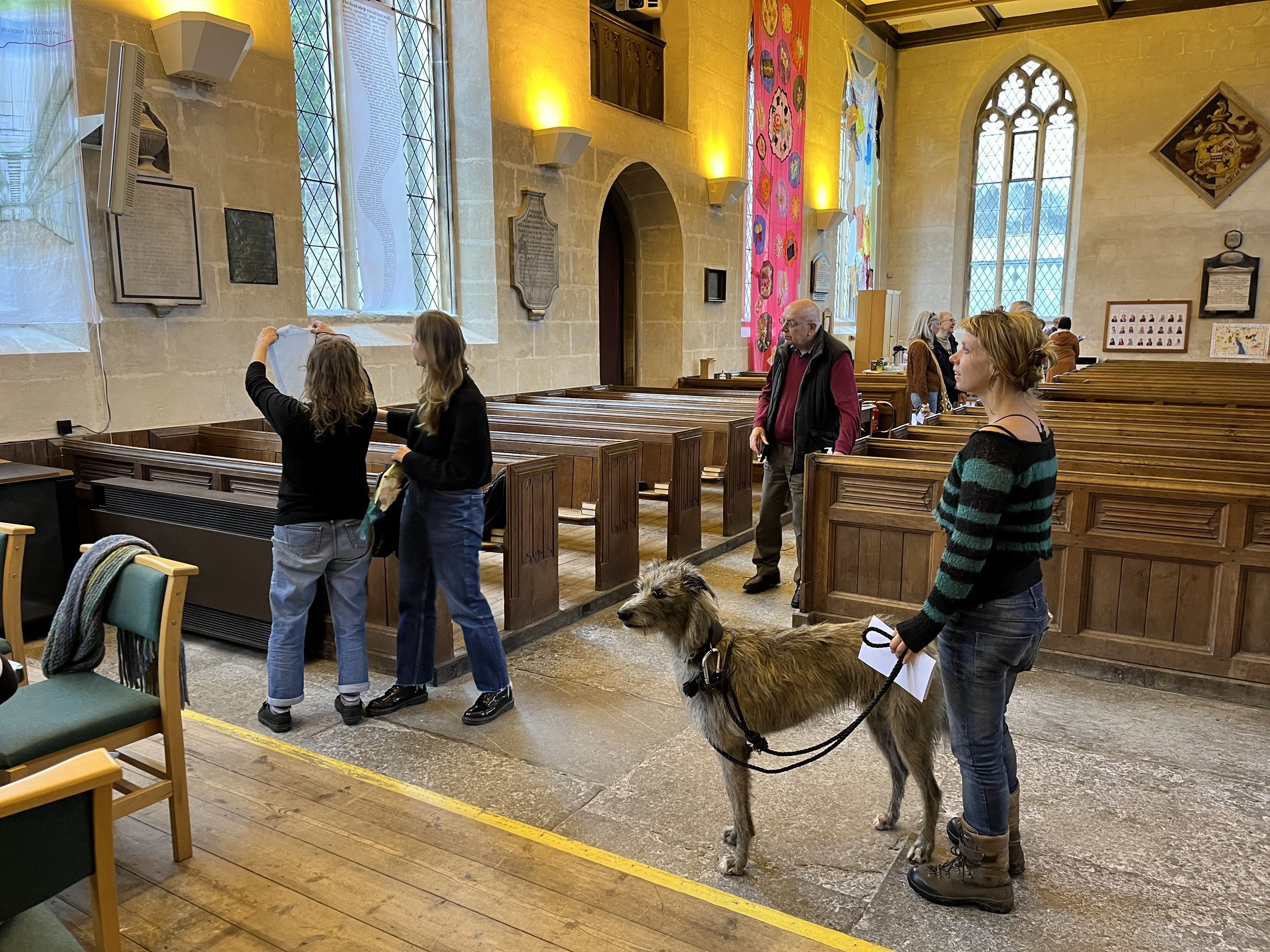
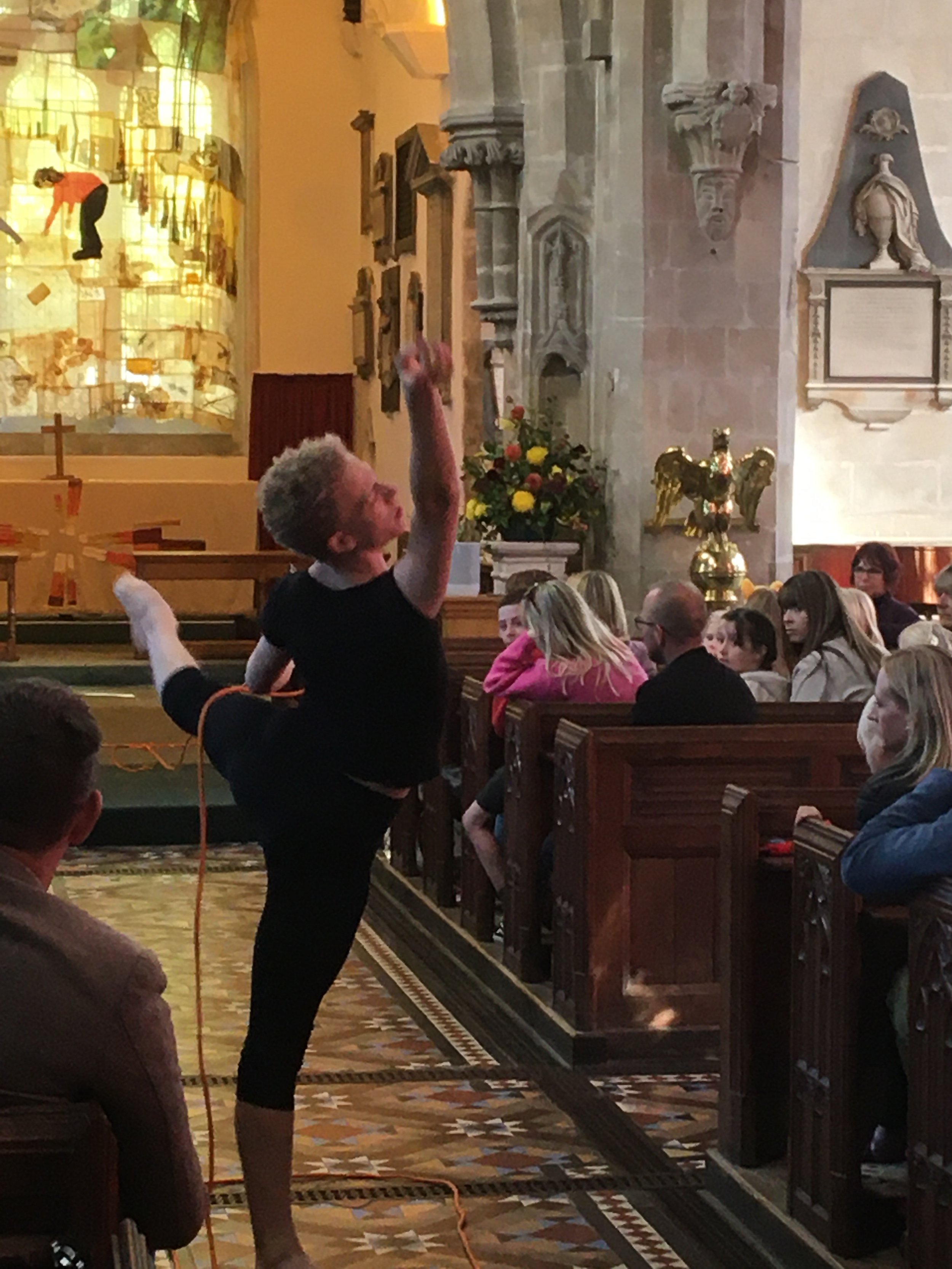
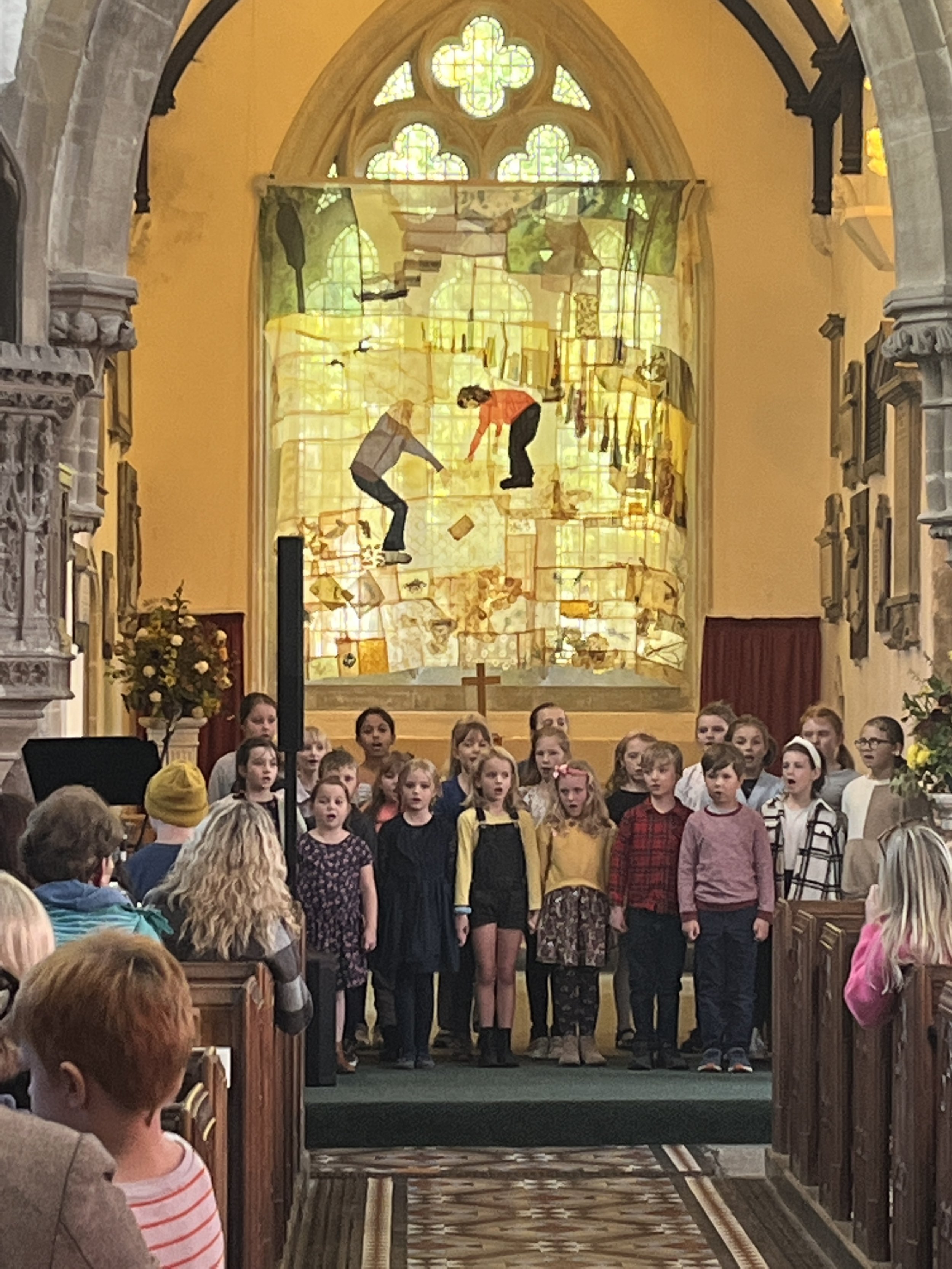
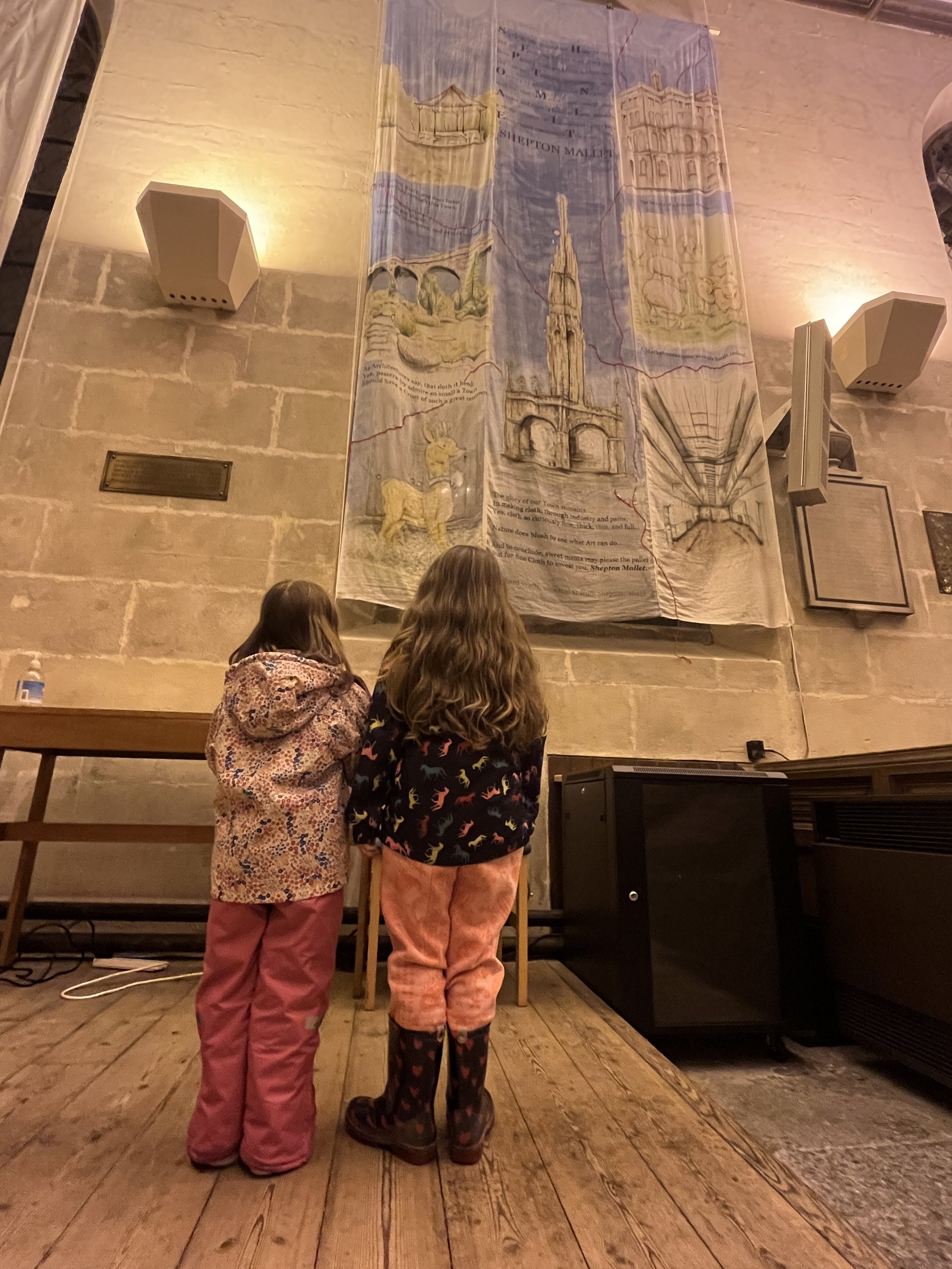

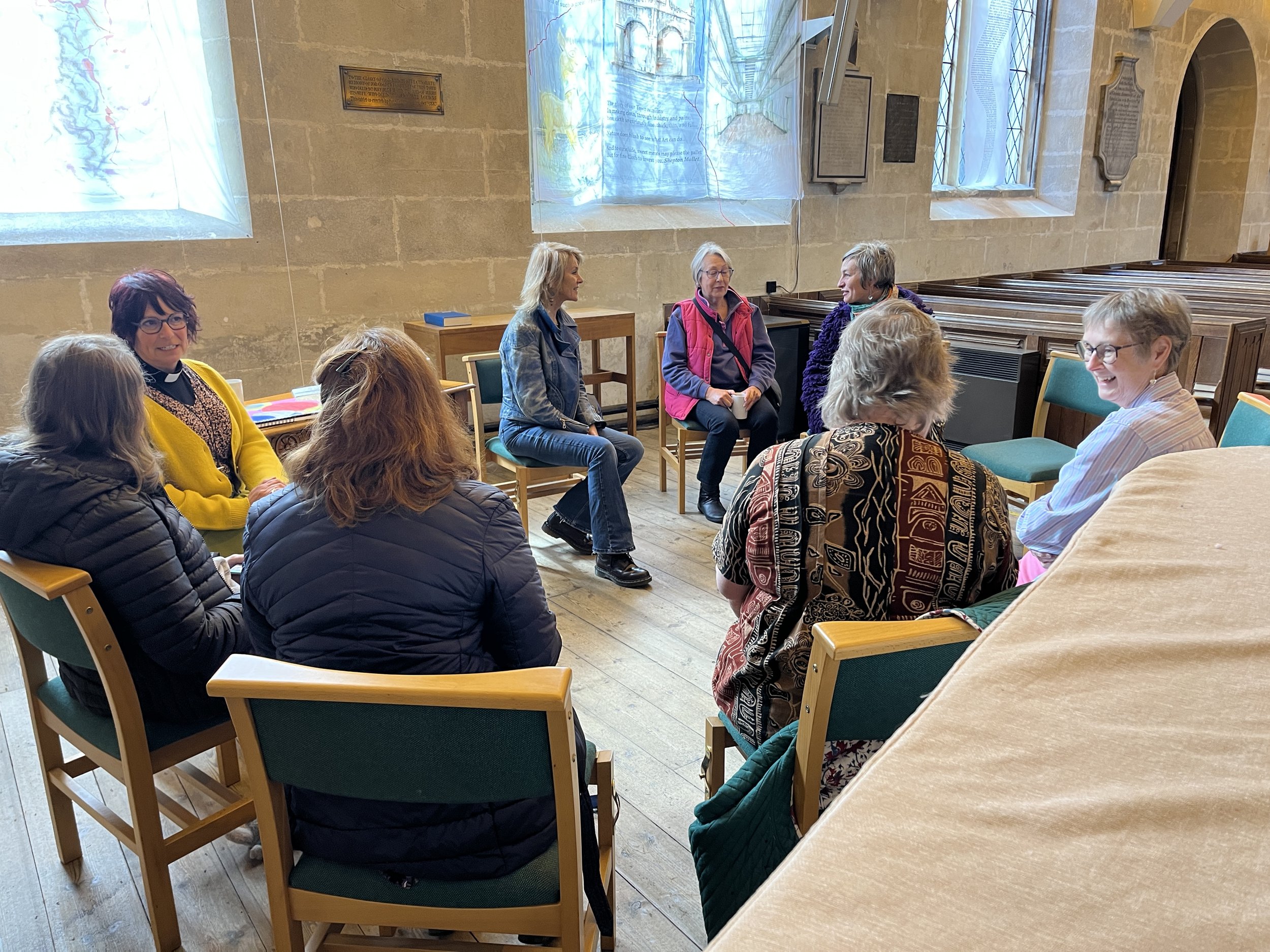
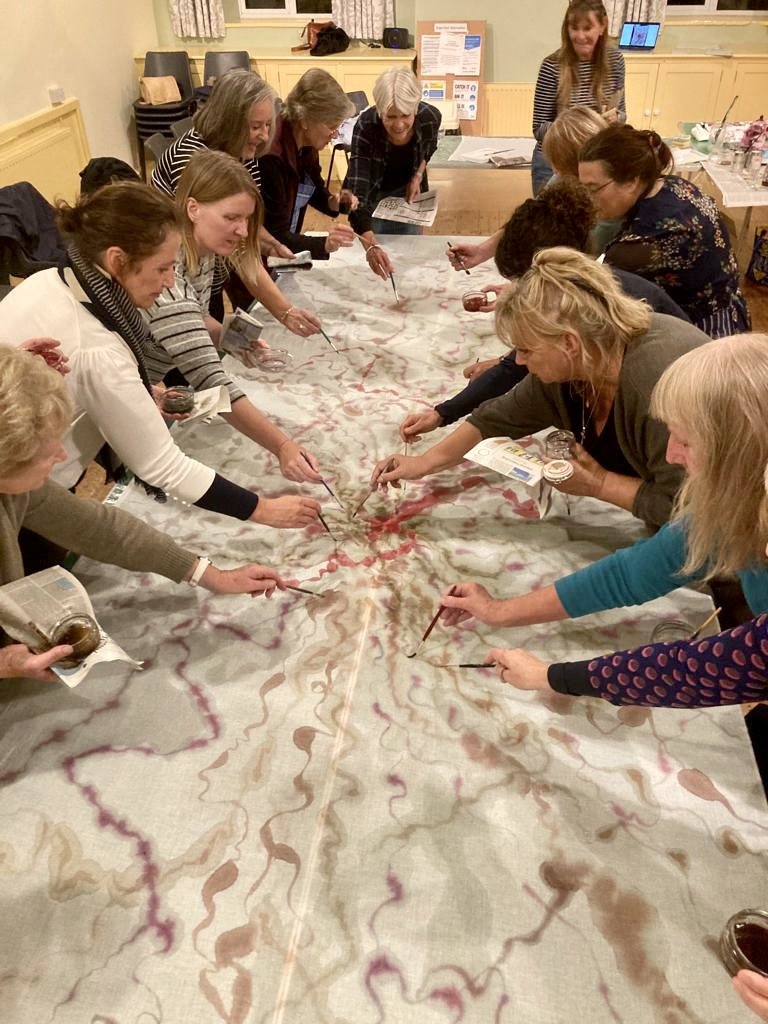
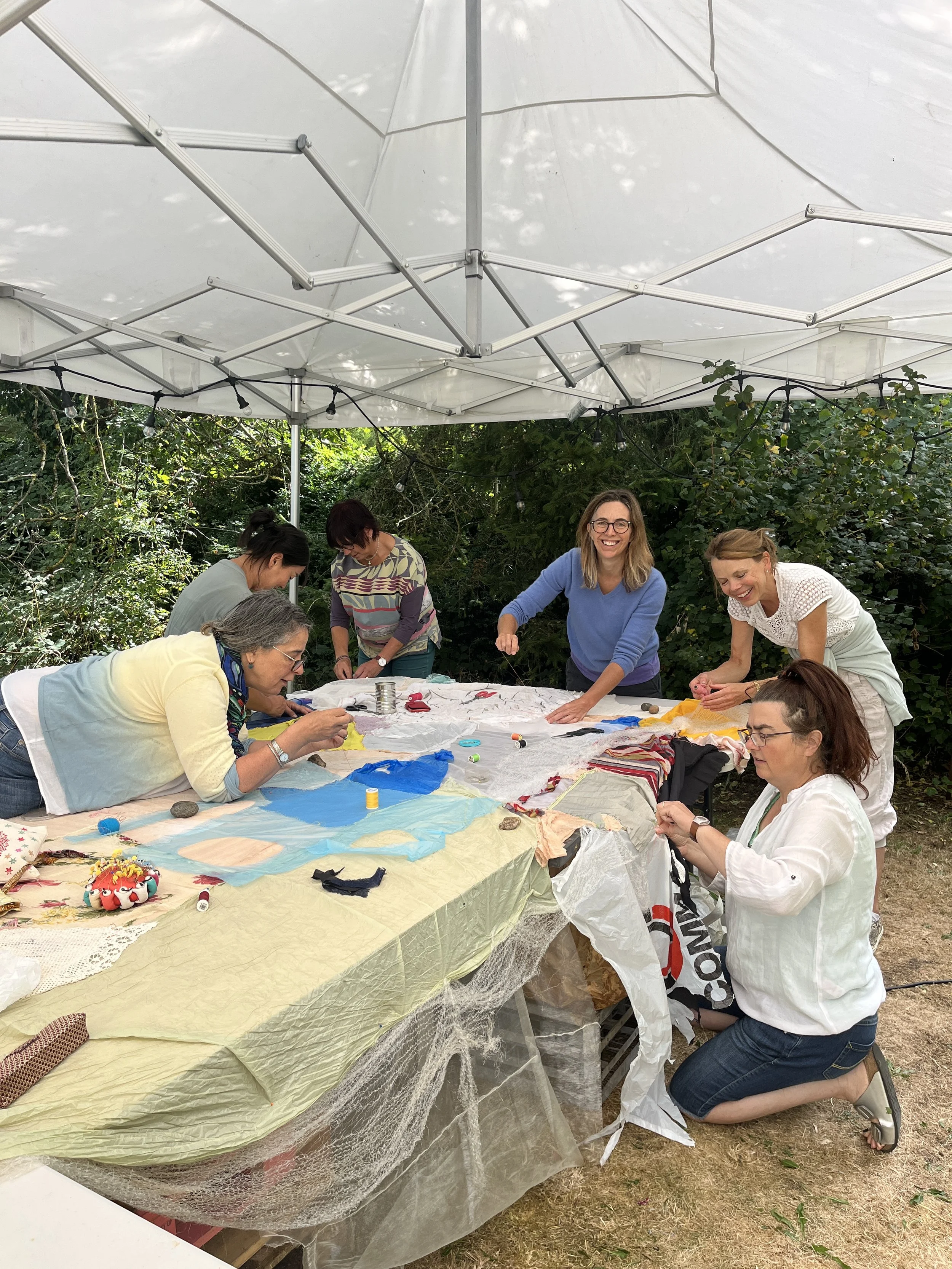


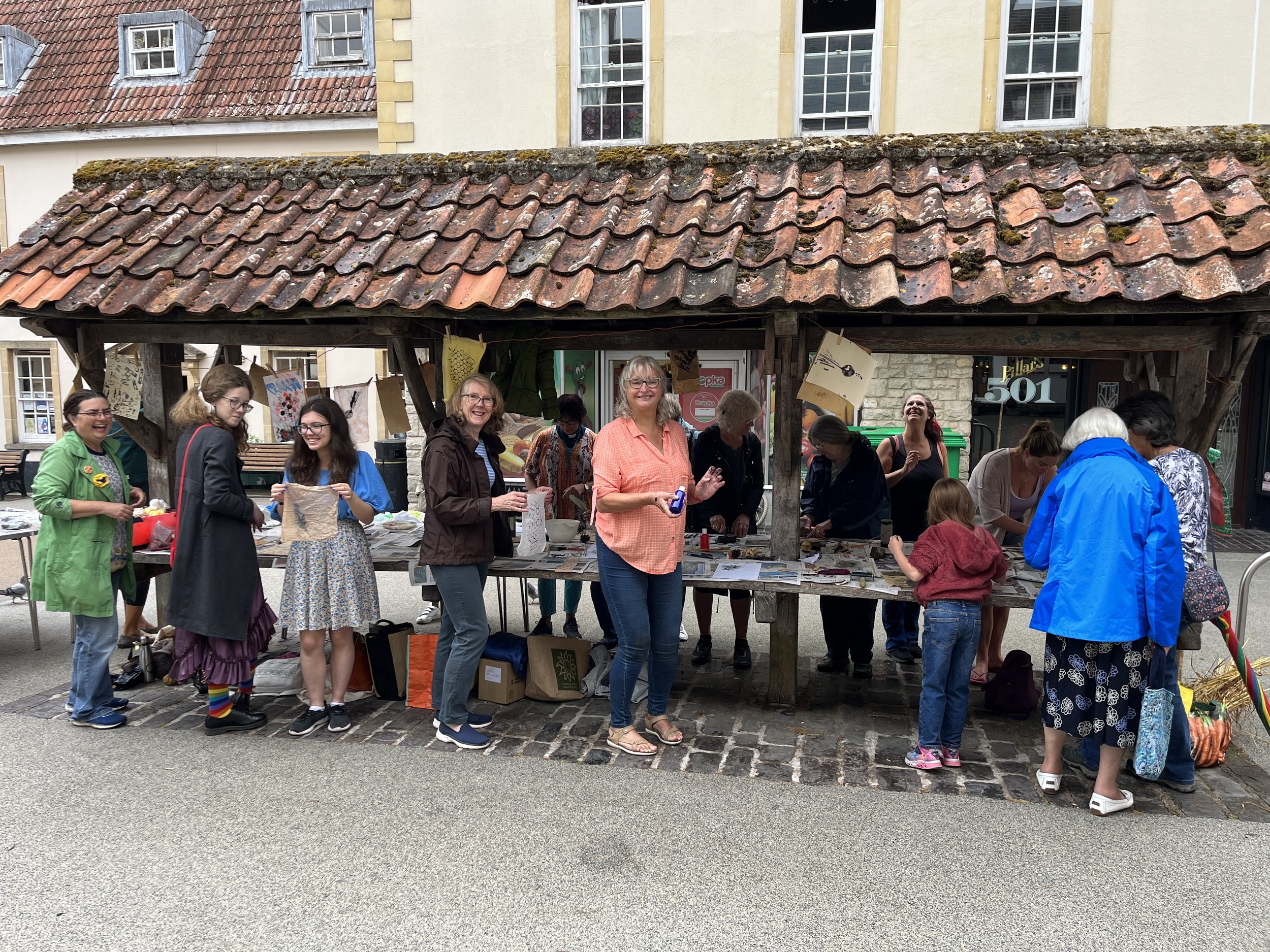
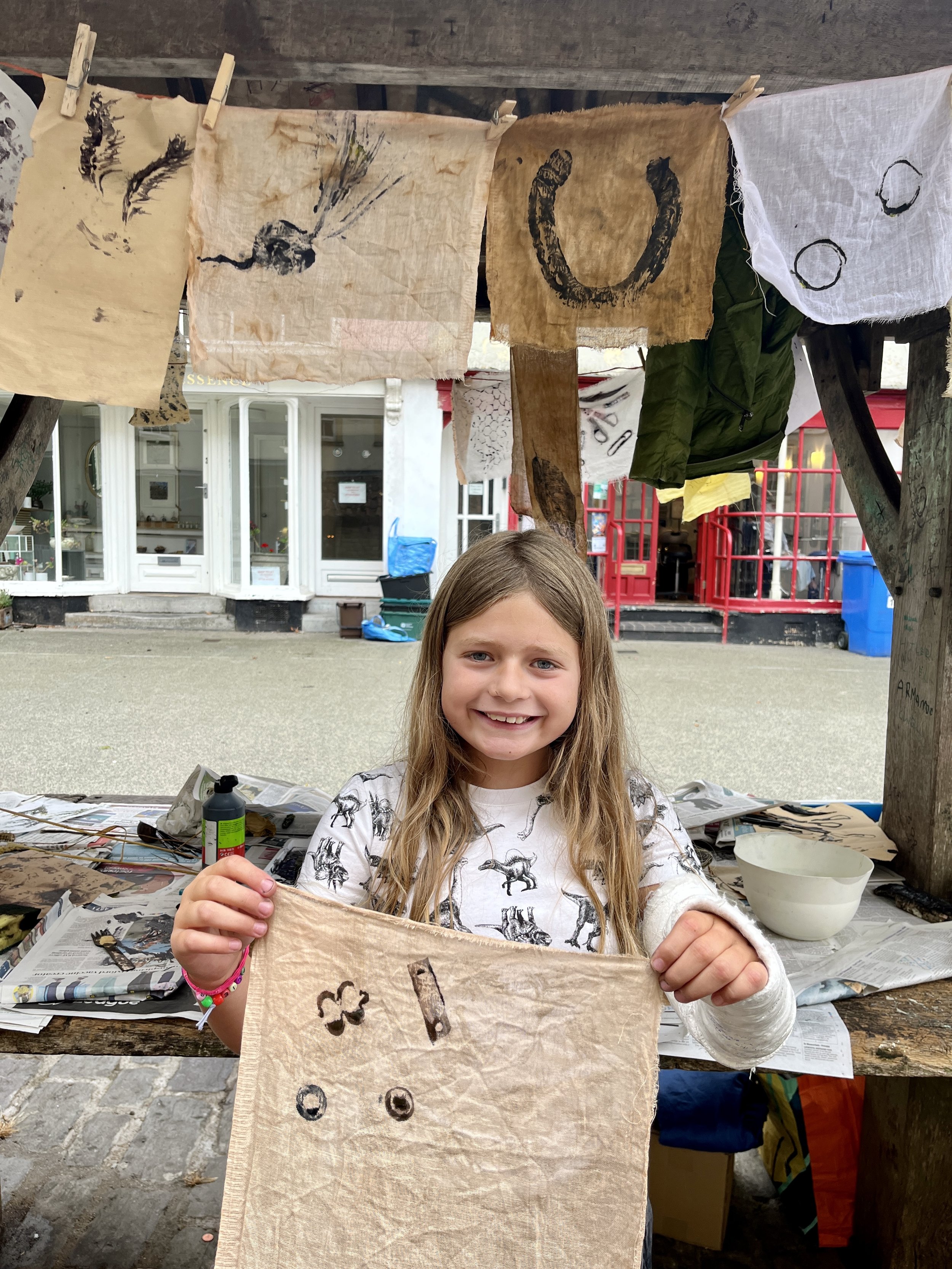


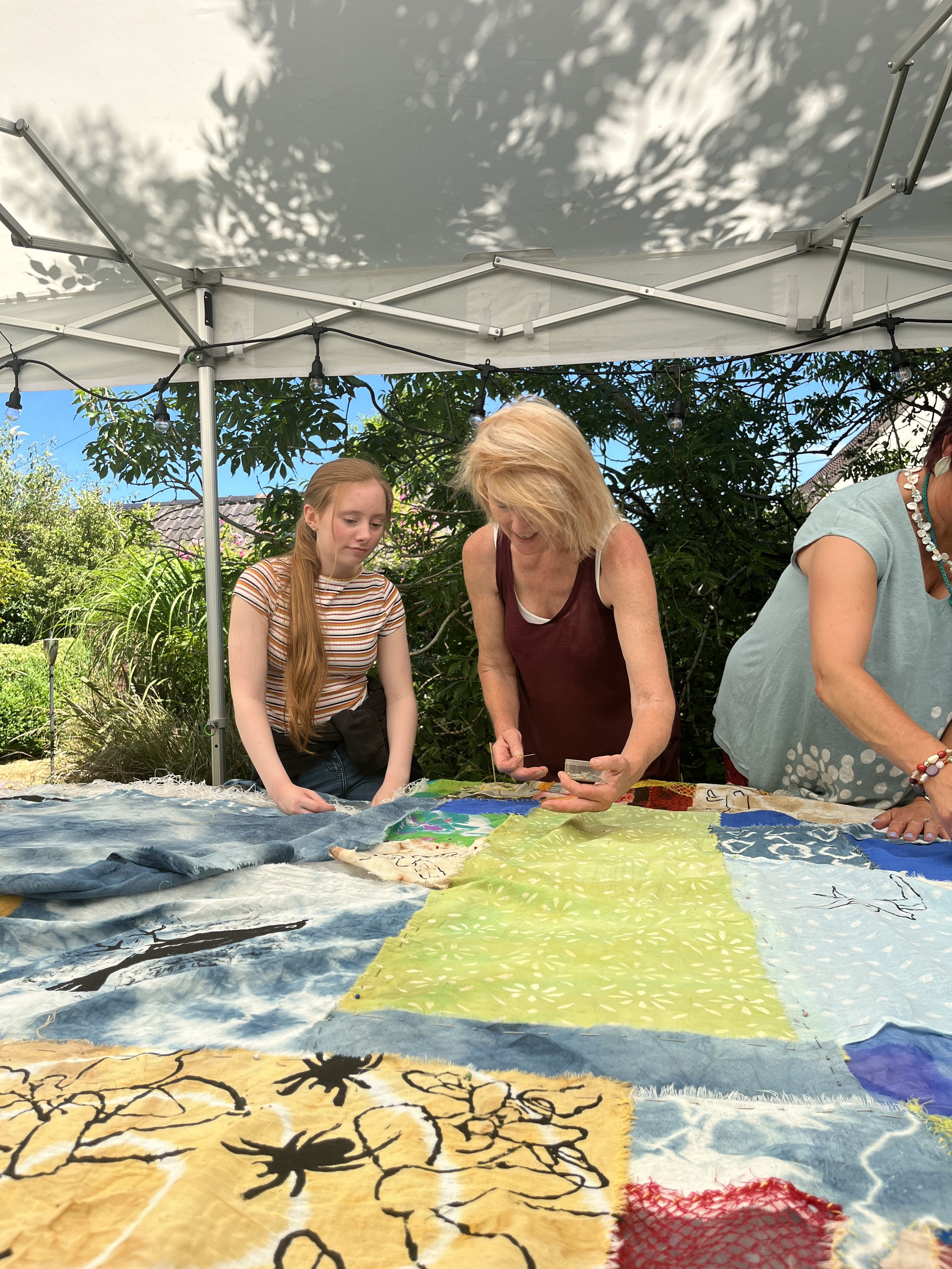





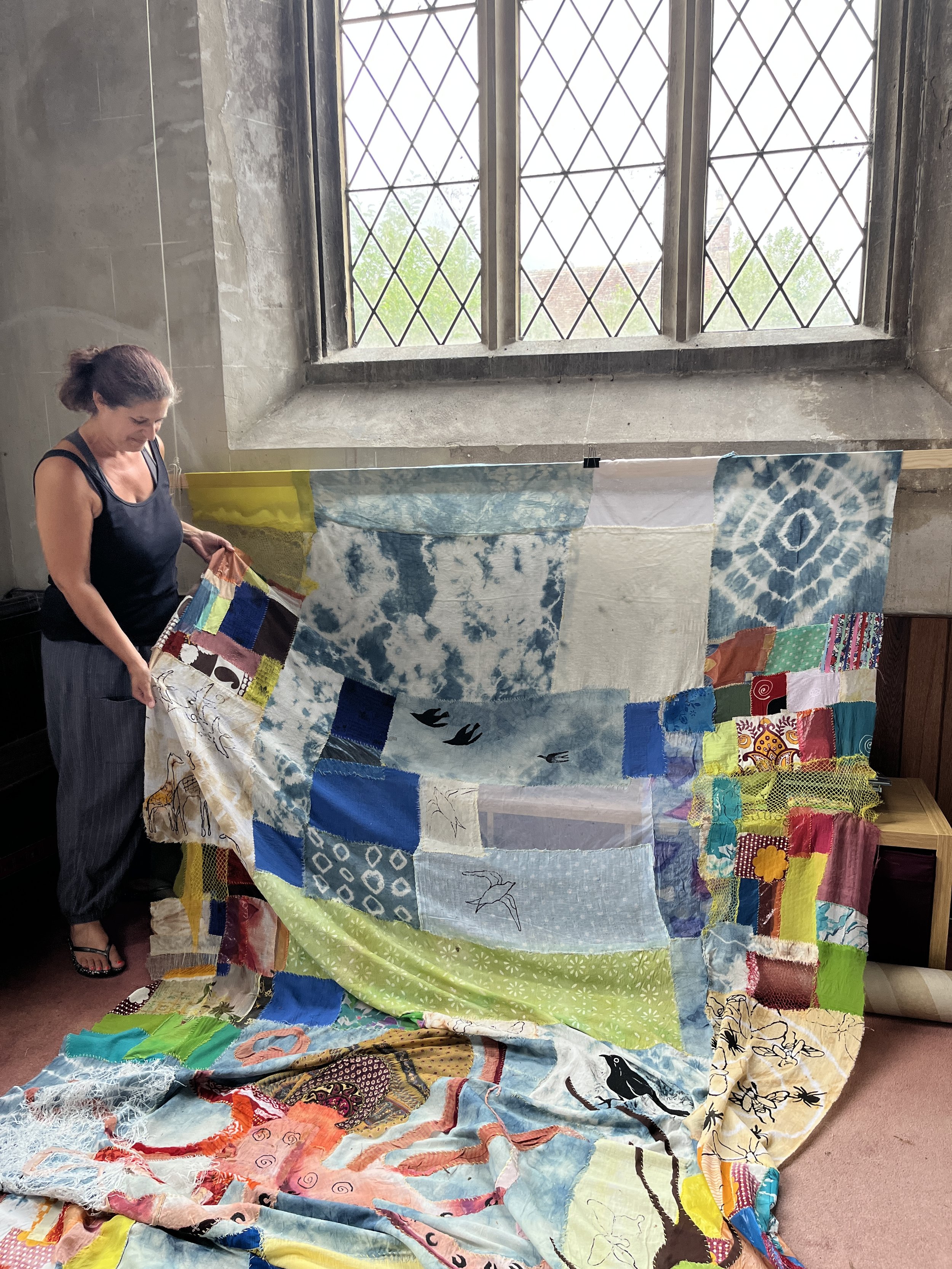
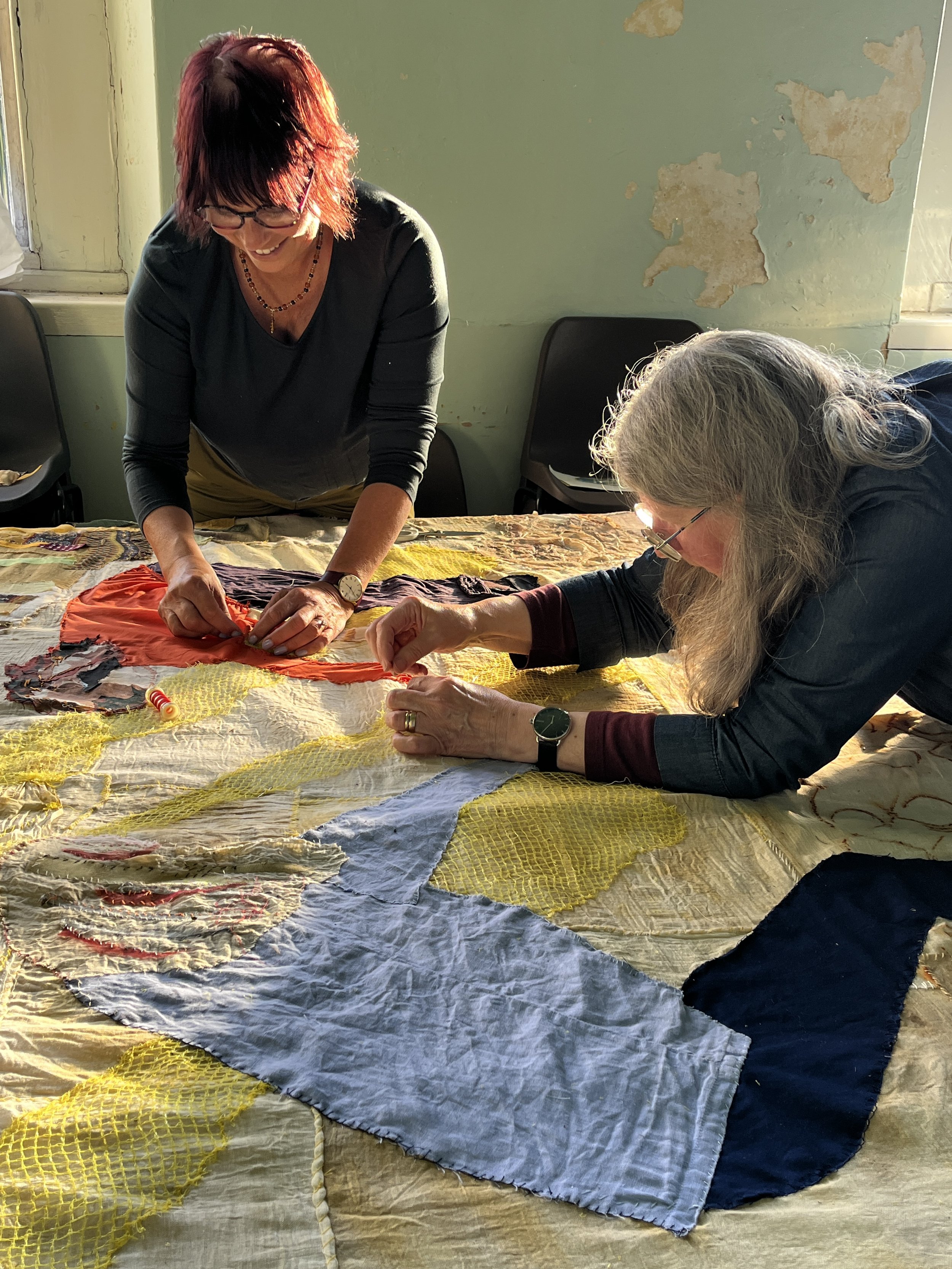
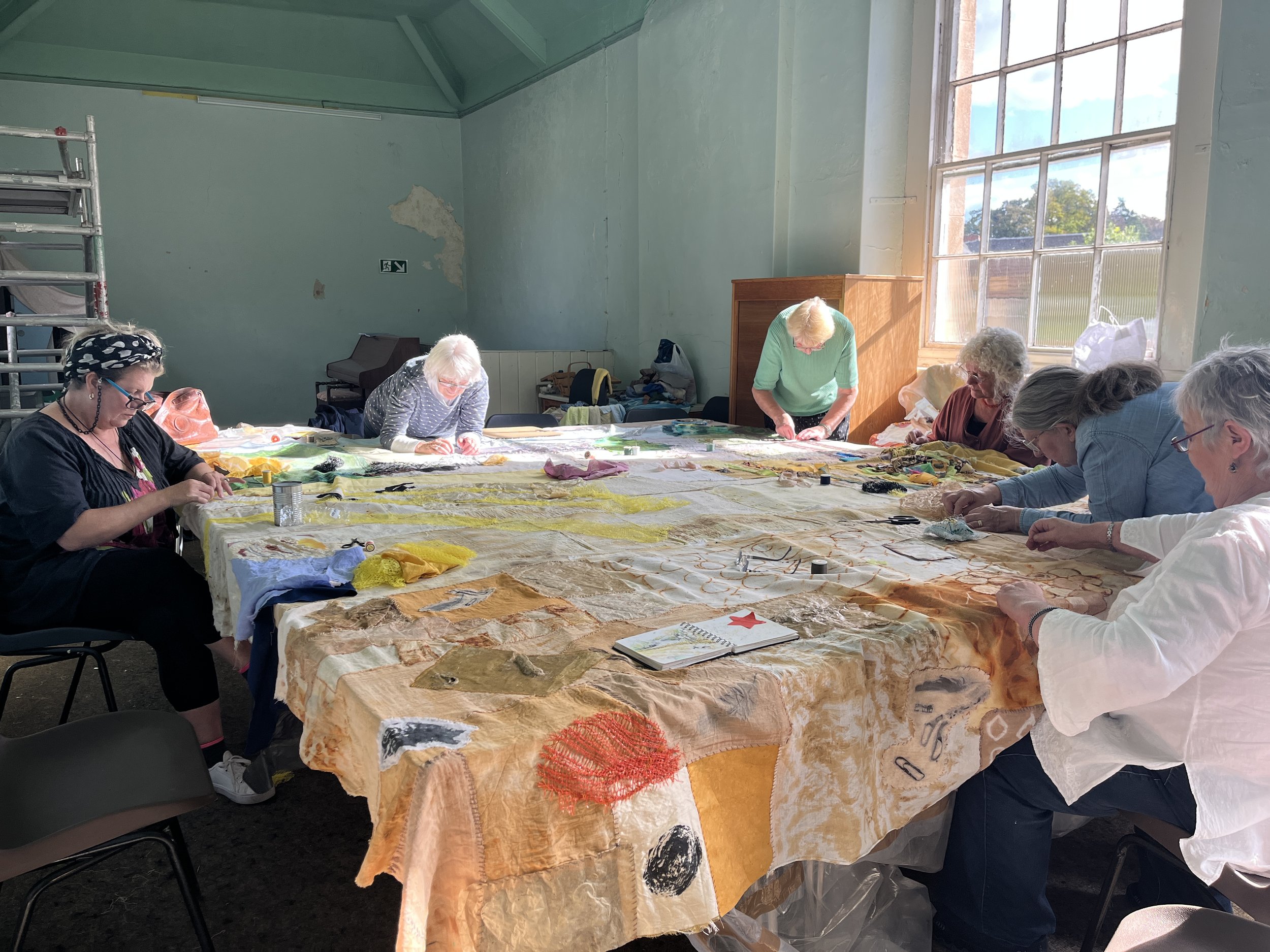
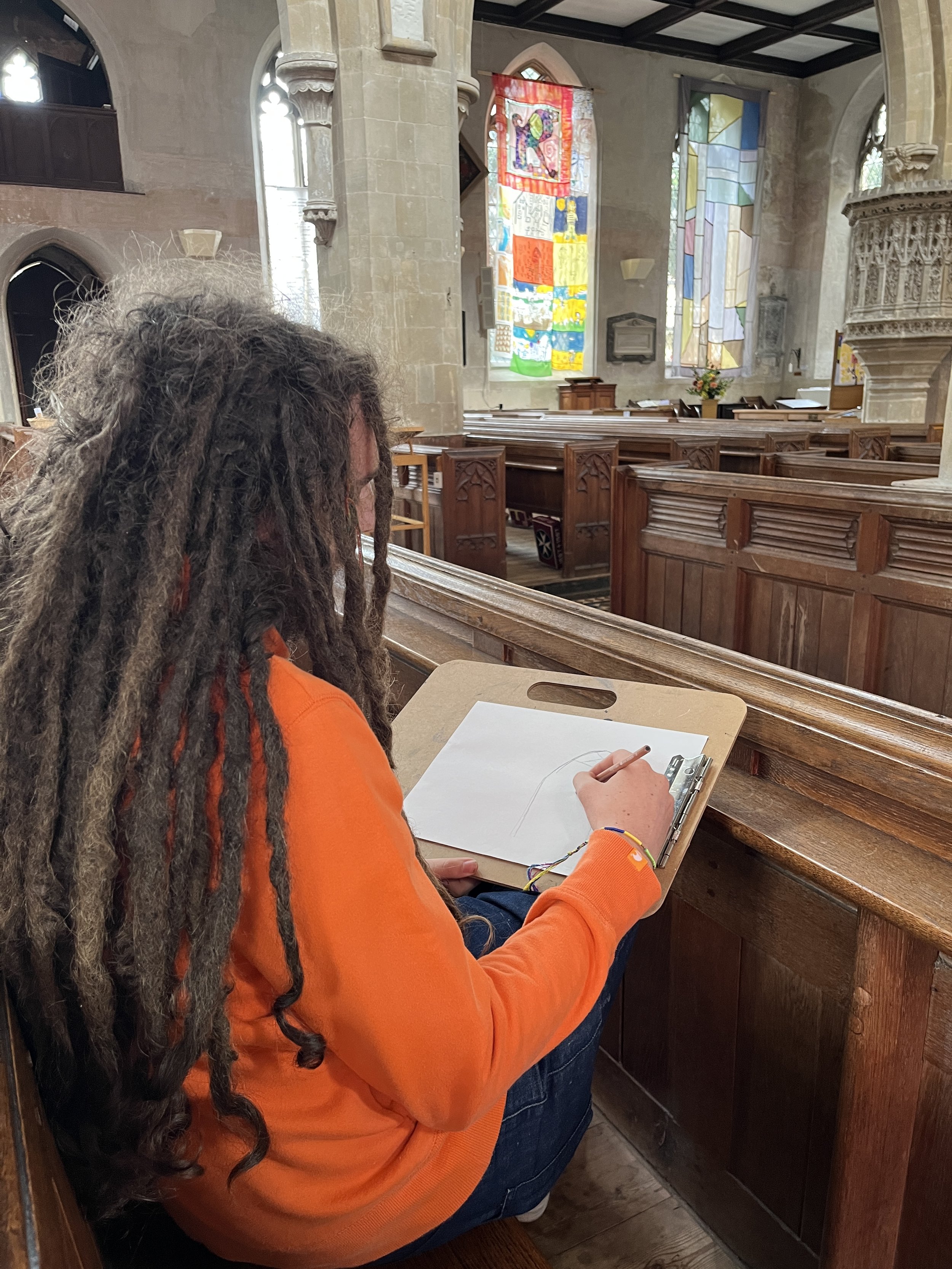

Photo Derek Webb
The Gleaning was a collaborative community arts project in 2022, involving people from all walks of life around Shepton Mallet to join together in making elements for an exhibition with events. Co-curated by artists Fiona Campbell and Gill Sakakini, working closely with writer Polly Hall, they weaved heritage with present lives.
Large-scale translucent textile and paper artworks were suspended in front of 11 clear glass windows in Shepton Mallet’s beautiful 12th century church. Created to represent light, looking beyond, raised vision, and different perspectives, each panel had a theme, interconnected visually and conceptually. Themes were: Earthlings, War and Conflict, Peace, Gratitude, Ruth’s Story, Shepton Mallet, Care and Repair, Journeys, Generosity, Interconnectedness, The Gleaners. Stories reflected different styles and cultures using found and recycled materials, all created with local community. Many processes were explored including drawing, collage, home-made plant dyeing/tie dye, print, batik, stitching, found poetry.. on recycled fabric, plastic and paper remnants, using natural inks, and fusing artisan craftsmanship with contemporary art. The project reconnected the community with environmental concerns.
The Gleaning references the Biblical rule of leaving a portion of one’s crop for the poorest to glean (Leviticus 19, v 9-10). The central thread of Harvest Festival celebrates plenty, gratitude, generosity, sharing, social cohesion, giving voice to the marginalised. The project addresses Somerset Art Works’ theme ‘Sanctuary’, with its key strands of the Spiritual, Sustainable and Social. The exhibition was in St Peter and St Paul’s Church, a spiritual venue, welcoming, safe, sacred. The oldest building in town, it has offered sanctuary to all comers throughout history.
A whole series of Art and Writing workshops over the summer offered free creative opportunities for all, some linking with Gill’s weekly Drawing On sessions in Collett Park. The Gleaning reconnected community with environment through the use of natural inks, recycled materials, and relevant themes, fusing artisan craftsmanship with contemporary art. Participants explored various forms of printing, applique, textiles collage, drawing, poetry and contemplative writing.
‘Through the arts, we’ve opened up space for dialogue and growth. The workshops have been like building blocks, giving a sense of belonging through intergenerational art-making’. (Curators Gill and Fiona)
The Gleaning collaborations culminated in a final exhibition as part of Somerset Art Weeks’ Festival, supported by events including a jazz concert, and dramatic presentation of the Book of Ruth. The exhibition ran from 22 September-l 14 October.
The project attracted an incredible response, with approximately 2080 visitors to the exhibition, and more participants leading up to it.
For further information, visit instagram: @thegleaning_shepton
COMMENTS BY VISITORS
Deeply touching - the themes, the community involvement - the beauty
So original! Spectacular and moving! Loved the community aspect (Ami Cook)
Came a long way to see the performance & all of this here at the Church is a total & wonderful surprise. Amazing work, bringing so many skills, & ideas together
Utterly breathtaking! Such a display of dedication, imagination & fragmentation to create dramatic diversity
An amazing achievement. Beautiful, sweet, heartfelt and inspiring. Clearly a huge amount of work and a great community coming together…
This is a wonderful creation. To have been part of the stitching, printing, making marks with other people, and to see the vision of sanctuary, community and gleaning come together in this beautiful church is awesome! Thank you Gill, Fiona, Polly and everyone. (Linda Staines, participant/visitor)
Another wonderful! You’ve triumphed! Love the stories, sense of community & above all, hope. A rich experience. (Paul Newman, Somerset Art Works)
I have found sanctuary in this art project, being part of it with other people (Jan Ladhams)
THANKS TO:
Supporters including Shepton Mallet Town Council, The Arts Society Wessex Area, Diocese of Bath & Wells, Glastonbury Festivals, The Eaton Fund, Cranmore Parish Council and Chrisi Kennedy.
Special thanks to Polly Hall, Bella Frey, Chris Lee, Rosalind Teesdale-Ives, Lizzie Britain, Steve Bruce-Jones, Alastair Bolt, Dominic Weston, Mark Adler, Vaughan Ives, Martyn Sheppard, Jenny Short and Beacon Photography Group.
And thanks to the many people who joined us in the making process, and who donated recycled materials to the project.
The project relied on a great deal of time, labour, goodwill and voluntary work.

Photo Jenny Short
The Gleaners
The Gleaners was the central panel in the exhibition, representing the whole project, a collaboration between Fiona, Gill and many others. Sited in the East end of the church, behind the high altar, The Gleaners pulls together threads from the other artworks in the show.
The piece is a contemporary interpretation of ‘The Gleaners’ by Jean Francois Millet (1857) and other artworks of gleaners. The term Gleaning references the Biblical rule of leaving a portion of one’s crop for the poorest to glean (Leviticus 19, v 9-10).
The work can be read on several layers. On the surface, it relates to harvest in the rural context, where this project takes place. Overlaid patches contain gleaned objects from local fields, roadsides, homes and gardens. These have been hand-stitched together by many hands. Some of these have been pressed and encapsulated in handmade khadi paper. Other found objects were printed onto fabric dyed with home-made botanical inks in a workshop supported by Shepton Mallet Town Council. Recycled fabric remnants come from far and wide, all with their own stories.
On another level, The Gleaners depicts wheat fields, which have a connection with the Eucharist, because bread, from the communion is made from wheat. The location of the art is close to the altar where the Eucharist is shared.
The Gleaners involved the most collaboration of all the panels from start to finish, and has been a true labour of love.

Photo Vaughan Ives
Earthlings
Earthlings represents a love for nature. Stories within a story celebrate creatures and plants, the importance of non-humans, and life’s interconnectedness. A pangolin (endangered species, most trafficked mammal in the world) features alongside an octopus escaping a trawling net, plant forms, insects and birds - highlighting the beauty and value of our natural world, from micro to macro.
The hand-stitched patchwork sections reflect different styles and cultures using found and recycled materials, created with the involvement of local community. Parts were printed in workshops on fabric dyed with home-made botanical inks which were developed. At Collett Park Day people of all ages helped create prints for the panels. Fergus Brindle (12), Pippa Wilkins (15, a Crispin School work experience student) and Juliet Duckworth worked with Fiona on parts of the panel. Many more people have been involved in donating fabric offcuts. Earthlings took several months to make. Of all the 11 panels, it was perhaps Fiona’s most personal and intensive contribution to The Gleaning.

Photo Jenny Short
This panel is about place, community and belonging. Developed in collaboration with the community of Shepton Mallet, home to this project - it features some of the town’s distinctive iconic architectural landmarks and emblems. Shepton Mallet is steeped in history, with a 14-1800 century wool and cloth making industry, once very profitable. The central image of Market Cross denotes a historic and much loved focal point in the heart of the town. Other images depict: B Wing, Shepton Mallet Prison (built 1610, oldest working prison in UK until closure in 2013); Collett Park bandstand; Anglo Trading Estate (grade II listed, built 1864 as Shepton Mallet Pale Ale Brewery, later renamed Anglo Bavarian Brewery); Sheep = Sheep Town: sheep fleece was used for fine woollen cloth; iconic railway viaducts overlooking Kilver Court gardens; Babysham emblem. Red wool denotes the main routes leading into Shepton Mallet.
In several free intergenerational community workshops, (one at the bandstand), drawings were developed on fabric using wax crayons and oil pastels, followed by ink. Inks were mainly homemade botanical mixtures including turmeric, onion skin, avocado pit, oak gall and buddleia. Wax resists ink - a way to build up colour in layers. The style was inspired by John Piper’s architectural paintings.
The panel combines image with text. Polly Hall worked with people in Shepton Mallet, gathering their responses about the town through acrostic poetry. The final acrostic poem features top centre. In between images, are extracts from a poem (1641) by Richard Watts, a shoemaker from Shepton Mallet, all hand written onto the fabric.

Photo Jenny Short
This co-created panel refers to the concept of care and repair, mending, healing, sharing, nurturing. Members of the community were invited to work with Fiona and Gill to hand-stitch recycled and waste fabric and plastic remnants together as a patchwork. A series of stitch and chat sessions involved various people working together in Fiona’s garden, under the shelter of a marquee, kindly loaned by Gill and Steve Sakakini.
There is a huge amount of waste and consumerism in the fashion industry, so old clothes were incorporated within the design. These were donated by many people.

Photo Martyn Sheppard
Approximately 20 women from the Strawberry Line WI, Cranmore co-created this panel in a 2 hour evening workshop with Gill and Fiona. Interconnectedness involved the concept of taking a line for a mindful walk, and relating this to roots, rhizomic connections, neurons, branches, rivers, and vascular systems. Together, the mapping lines evolved, separate parts becoming the whole.
Most of the dyes had been hand-made with natural ingredients, some contributed by members of the group. Elizabeth Hadwin’s walnuts made a brown, leftover avocado pits made fleshy red, and berry mixtures (including strawberries) provided stronger pinks. Other dyes came from pomegranate, oak galls, onion skins. Red ink was also used.
It was fun all working together, and fascinating to watch the inks react. The appropriateness of the concept tied in with the name of the group - Strawberry Line, which refers to the old railway line that ran through Cranmore to Shepton Mallet, transporting strawberries.
It was particularly special to hold this session in Cranmore where Fiona and Gill are both based. The project has also been supported by Cranmore Parish Council.

Photo Martyn Sheppard
A visit by Fiona and Gill to the Romanian Cake shop one particular day prompted a conversation about a special cake Elena and Cristina were making and generously offered them to taste. Mucenici, is a traditional Romanian pastry cake shaped like the infinity symbol or figure of eight and is glazed with honey syrup and topped with walnuts. It’s made once a year on March 9th to celebrate the feast day of the Forty Martyrs of Sebaste who were frozen to death in an icy lake because of their faith in God.
At a workshop at Collett Park Day people of all ages designed and printed the borders of plates using motifs from Polish and Romanian folk art. The story of Mucenici was gleaned and led to a workshop at ‘Sweet 11’ thanks to Elena and Cristina’s warm hospitality and welcome. People told cake stories from all traditions and languages; they drew, ate, and re-made them in collaged appliqué.
The colourful and abundant cakes spill off the edges of a red fabric cloth which pools on the floor evoking the spilt blood of the martyrs. However, some plates remain empty in an acknowledgement that food poverty is a reality for many.

Photo Andy Ladhams
There are many reasons for a journey: leisure, work, nomadic lifestyle, impulse, migration, escape, adventure, pilgrimage, return, conquest or exploration. One of the definitions of ‘gleaning’ is associated with wool gathering, an apt subject related to the history of Shepton Mallet. It refers to the collecting of tufts of wool caught on the bushes. Other etymology likens wool-gathering to the wanderings or journeys of the mind. Using the starting point of ‘the first step’ workshop participants were invited to continue their journey by writing thoughts and contemplations as they moved. This was inspired by the contemplative or meditative practice of walking in silence in nature. This panel consists of harvested words from a workshop in the church and presented in a meandering form representing movement, perhaps a road or a river estuary.
Panel created by Polly Hall in collaboration with curators and the community

Photo Vaughan Ives
This panel was inspired by a painting, 'The Baptism of Christ’ by Piero della Francesca, 1450s (National Gallery, London). It is a monumentally vertical painting of Jesus being baptised by John, and a tall tree evokes the Divine presence from where a voice comes, ‘This is my beloved Son, in whom I am well pleased’. Above Christ, in the only horizontal plane, is a dove with outstretched wings, which is a symbol of the Holy Spirit and peace. In designing this panel we pixelated the composition to reveal the essential harmony of forms.
It has been made in Bojagi style, a traditional Korean patchwork which combines large angular shapes and was originally used as cloth for carrying items. This art form uses remnants from making garments, and Peace was created from similar fragments, mostly hand-dyed using dyes from turmeric, black beans, avocado, beetroot, onion skins, and mint. The seams trace the prominent angles from the painting and echo its colour palette to create simplicity and balance.
Designed in collaboration with Bella Frey, a Korean born artist living in Shepton Mallet. Bella dyed the fabrics and stitched Peace, exploring her Korean heritage through the making.

Photo Martyn Sheppard
Perhaps the darkest theme to reflect upon. Yet the presence of war, conflict or brokenness is a part of the world we inhabit and cannot be ignored. Poets and writers have captured the essence of conflict over the centuries. Whose experience do we record? How do we comprehend another’s experience especially that of trauma induced by war and conflict? Writing workshops encouraged the process of creating something new through found text likened to the act of gathering that which has been left behind or discarded. Found poetry is a form that takes existing text and through omission, redaction or highlighting certain words, a new poem is formed. Like the process of gleaning, words can be harvested to form something new. These new poems were selected and certain words were enlarged to demonstrate the louder sounds associated with conflict set among the smaller words that sit among the broken pattern of text. Incomprehensible and cut into pieces this panel is meant to portray a shattered window.
Panel created by Polly Hall in collaboration with curators and the community

Photo Martyn Sheppard
Gleaning references the story of Ruth in the Old Testament and this panel is inspired by Medieval manuscripts of the Bible in hand written script and illustrations on stitched pages. The ‘illuminated’ or decorated capital ‘R’ identifies the main character in the story and the narrative cascades downwards unfolding the plot. Paintings were made by children from Horrington Primary School who encountered Ruth through the story-telling method of Godly Play.
Reading from the top, Ruth leaves her country of Moab because of a famine in the land. On the deaths of her husband and father-in-law she commits to follow and devote herself to Naomi, her mother-in-law in a selfless way, to live where she lives, and worship the God she loves, even though she is a stranger in the new land. Their journey resonates with those of refugees, displaced in our time and seeking a safe place to live. Ruth encounters Boaz, a land owner, who allows her to glean left-over wheat from the margins of his fields to avoid starvation. Her loving kindness and care for others impresses him and he eventually marries Ruth and ensures the well-being of both women. Boaz and Ruth’s relationship is significant because their son is in the line of King David and eventually, Jesus, who brings hope and redemption. As part of the events at The Gleaning the book of Ruth will be enacted outside with voice and viola.

One of The Gleaning’s highlight events was ‘Song and Celebration’. Giving young people an opportunity to perform after the interruption of covid was a wonderful experience. Performers ranged from ages 5-22.
St Paul’s Junior School choir and Bowlish Infants School responded to the harvest theme, 3 students from The Chapel Dance Studio performed beautifully as gleaners. Gregory Steward (tenor) sang a range including a song from Les Miserables. Joe Ducille’s balletic responses to various panels was mesmerising.

One of The Gleaning’s highlight events was ‘Song and Celebration’. Giving young people an opportunity to perform after the interruption of covid was a wonderful experience. Performers ranged from ages 5-22.
St Paul’s Junior School choir and Bowlish Infants School responded to the harvest theme, 3 students from The Chapel Dance Studio performed beautifully as gleaners. Gregory Steward (tenor) sang a range including a song from Les Miserables. Joe Ducille’s balletic responses to various panels was mesmerising.

Approximately 20 women from the Strawberry Line WI, Cranmore co-created this panel in a 2 hour evening workshop with Fiona and Gill. Most of the dyes had been hand-made with natural ingredients, some contributed by members of the group.

Participants working on the Care & Repair panel. Each panel involved community participation. Many hands worked together in the making of the Care & Repair panel in Fiona’s garden, all hand-stitched re-using donated and found materials. The title refers to the concept of care and repair, mending, healing, sharing, nurturing.

Overlaid patches contain gleaned objects from local fields, roadsides, homes and gardens. Fiona encapsulated some objects in handmade khadi paper. Other found objects were printed onto fabric dyed with home-made botanical inks in a workshop supported by Shepton Mallet Town Council. Recycled fabric remnants came from far and wide, all with their own stories.
These were hand-stitched together by many hands, led by Fiona and Gill. The Gleaners involved the most collaboration of all the panels from start to finish - a labour of love.

Mono printing workshop on prepared collaged and stitched fabric, led by Fiona and Gill. Despite the rain, the workshop was well attended and enjoyed by a range of ages. Prints were incorporated into The Gleaners panel.

All ages worked together in a mono printing workshop led by Fiona and Gill. Found objects were used to make imprints on botanical dyed fabric remnants. Prints were incorporated into The Gleaners panel.

A series of Art and Writing workshops offered free creative opportunities for all. Participants explored various forms of printing, applique, textiles collage, drawing, poetry and contemplative writing.
The first Gleaning workshop was held at Collett Park, Shepton Mallet as part of Collett Park Day, led by Gill, Fiona and Polly. All ages joined in and learnt how to make mono, lino and string prints on re-used fabric. These were later added to Earthlings and Generosity and Gratitude panels.

In several free intergenerational community workshops, (one at the church), drawings were developed on fabric using wax crayons and oil pastels, followed by ink. For this market cross drawing (the central image for the Shepton Mallet panel) Fiona prepared a large-scale drawing, which participants then traced onto fabric. Inks were mainly homemade botanical mixtures including turmeric, onion skin, avocado pit, oak gall and buddleia. Wax resists ink - a way to build up colour in layers. The style was inspired by John Piper’s architectural paintings.

Fiona led a couple of workshops at Collett Park, Shepton Mallet. Participants added their marks in ink and oil pastel to a collaborative fabric drawing, which became part of the Shepton Mallet panel. Each image denoted an iconic architectural landmark or emblem linked to the town.

Fiona led a Drawing On Gleaning Special Workshop at Collett Park, Shepton Mallet. Participants added their marks in ink and oil pastel to a collaborative fabric drawing. This one was based on the iconic bandstand in the park, seen in the background. It became part of the Shepton Mallet panel.

At a workshop in ‘Sweet 11’. Romanian cafe, participants of all ages brought cakes, drew, ate, and re-interpreted them in collaged and hand-stitched appliqué, using motifs from Polish and Romanian folk art. This linked to the story of Mucenici (see Generosity panel). People told cake stories from all traditions and languages. The appliqué cakes were added to the Generosity panel.